Kenneth L. Gentry Jr.'s Blog, page 3
July 15, 2025
HYPERPRETERISM VS. THE GOSPEL (1)
PMW 2025-058 by Kenneth L. Gentry, Jr.
Introduction
Hyper-preterism in all of its various, warring branches is heretical at its very core. By “hyper-preterism” I am not limiting the concept to what is known as “full preterism” or “consistent preterism.” such a definition practice is a common maneuver by hyper-preterists who are not absolutely and fully preterist in every single detail. By doing this, they can claim: “I am not a FULL preterist,” thinking that this declaration allows them to avoid the charge of being “hyper.” They are hoping this will allow them to fly under the radar and not be charged with eroding the foundations of the Christian faith.
Rather, I am more narrowly applying this distinctive term to the core issues that breach orthodoxy, whether each-and-every nuance of some full or consistent preterist is adopted. The label “hyper-preterist,” therefore, applies to any system of preterism that denies three key evangelical (orthodox) doctrines known as “The Three R’s of Eschatology.” Those doctrines that are denied by “hyper-preterists” are:
1. The Return of Christ (at the end of history in bodily, physical form).
2. The Resurrection of the dead (at the end of history in bodily, physical form— despite how “difficult” this might be for God.
3. The Renewal of all creation (after the resurrection as the new creation is established in its final, physical, eternal form).
In this short study series I will be speaking against hyper-preterism by showing that it ultimately denies the very gospel of Jesus Christ. I will do this by focusing on the doctrine of the physical resurrection of the body at the end of history, which is a key component of historic orthodoxy and is directly related to Paul’s definition of the gospel (I will get to this point eventually in this series).
More particularly, however, I will be highlighting the resurrection as it appears in 1 Corinthians 15. This portion of Scripture is the pre-eminent chapter for declaring and explaining the Christian’s future, corporate, consummate, physical resurrection. But as we begin I would note that we cannot selectively pluck its verses out of their context, as I showed in my preceding post on the topic (PMW 2025-057: “Flesh and Blood Cannot Inherit the Kingdom of God?”). I would highlight two key reasons for this warning.
First, the issue of immediate context. In my previous posting I noted the importance of recognizing Paul’s carefully-designed rhetorical structure that governs a particular unit of thought within this chapter. And that structural unit trips up neo-Gnostic hyper-preterists. [1] I argued that we must recognize the immediate contextual setting of 1 Corinthians 15:50. Since the recent arising of hyper-preterism, that verse has too often been used alone, divorced from its context. It has become a bumper sticker for hyper-preterists. But it is not a stand-alone verse. It actually opens a distinct, four-verse, inter-connected unit of thought (vv. 50–53) that warns that “flesh and blood cannot inherit the kingdom of God” (v. 50).
Reformed Eschatology in the Writings of Geerhardus Vos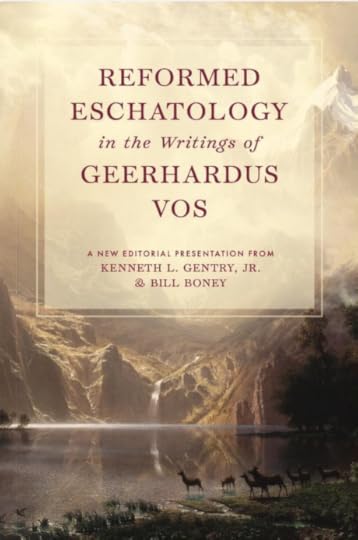
Ed. by Ken Gentry and Bill Boney
This is a collection of several key eschatological studies by the renowned Reformed theologian Geehardus Vos. We have modernized Vos’ grammar and syntax and updated his layout style according to modern publishing conventions (shorter sentences and paragraphs). We did this without changing any of Vos’ arguments.
For more information on this new Vos work or to order it, see:
https://www.kennethgentry.com/reformed-eschatology-in-the-writings-of-geerhardus-vos/
We saw that verse 50 has been misinterpreted by ancient Gnostics (“full” Gnostics, you might say!), recent liberals, and contemporary hyper-preterists (neo-Gnostics). This doctrinal stumbling is caused by not recognizing that Paul engages in a carefully-structured argument here. His rhetorical argument employs a synonymous parallelism that unfolds in a concentric movement driving home a particular point (see that article). And that preceding article was just one short discussion of one small unit in this lengthy chapter, a chapter whose sheer size and complexity requires much more discussion.
Second, the issue of the whole-book context. So now I would warn the would-be interpreter not to overlook the much larger context of 1 Corinthians 15 as a whole. That is, we should understand 1 Corinthians 15:50 in its place within the flow of the entire epistle. This requires that we understand Paul’s special concern in his letter to the Corinthians. That concern, as we shall see, prepares us for the importance of properly understanding the believer’s bodily resurrection.
In other words, chapter 15 is not some disconnected aside in this lengthy letter (per some liberal scholars). Paul is not randomly throwing it in as just one more issue as he prepares to close his epistle in 1 Corinthians 16:1–24. He is not saying, “Oh, yeah! Before we close let’s focus for a moment on just one more thing. I have another 10 inches of scroll left.” In fact, he has purposefully placed his resurrection material of chapter 15 at the end of his epistle as its very goal and high point. And understanding this lends even greater significance to the resurrection of our material bodies. In this current series I will show how this is the case. So, let’s begin by considering:
Paul’s Introduction
After his formal introduction to his epistle in 1 Corinthians 1:1–9, Paul opens the main body of his letter at verse 10. Here we see a statement of his key concern regarding the church at Corinth, which he hopes to overcome:
“Now I exhort you, brethren, by the name of our Lord Jesus Christ, that you all agree and that there be no divisions [schismata] among you, but that you be made complete in the same mind and in the same judgment.”
Greatness of the Great Commission (by Ken Gentry)
An insightful analysis of the full implications of the great commission as given in Matthew 28:18-20. Impacts postmillennialism as well as the whole Christian worldview.
See more study materials at: www.KennethGentry.com
Verse 10 contains his first parakaleo (exhortation) clause in the letter (see the Greek also at 4:16; 16:12, 15). And this appears surprisingly early in his letter: immediately after completing the letter’s formal introduction (1:1–9). Contrast this to Romans which places its first exhortation clause at 12:1! This maneuver emphasizes Paul’s deep concern as he deals with the Corinthians. Although he highlights numerous concerns regarding this troubled church (relational, moral, ecclesiastical, sacramental, etc.), here we will see that his core concern, his opening concern is: doctrinal.
Here in v. 10 Paul exhorts the Corinthians to be unified. But unified in what? As we will see, he is urging unity in doctrine. Note that he expressly urges them to “agree,” which in the Greek literally means: “that you all say the same thing” (hina to auto legete pantes), i.e., that you speak (affirm, teach, proclaim) the same truths. This exhortation is clearly doctrinal for it is designed so that they be “made complete in the same mind and in the same judgment.”
Consequently, Paul explains that at the root of their “divisions” [schismata] are doctrinal concerns. He exhorts them that they must be of “the same mind,” i.e., “united in your beliefs” (NJB). And of “the same judgment [gnome],” i.e., the same “viewpoint or way of thinking” (BAGD), “thought” (NIV).
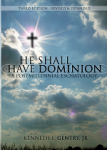
He Shall Have Dominion
(paperback by Kenneth Gentry)
A classic, thorough explanation and defense of postmillennialism (600+ pages). Complete with several chapters answering specific objections.
See more study materials at: www.KennethGentry.com
Key details
But now we must note that even at the conclusion of his introduction to this lengthy epistle in verses 7–9, he already anticipates the conclusion of his theological argument as a whole, which is found in chapter 15. Thus, his introduction points to his conclusion. What do I mean? How is this so?
Here in 1:7–9, Paul encourages the Corinthians to remember that they are to be “awaiting eagerly the revelation of our Lord Jesus Christ” (1:7), i.e., his second coming. And they must understand that the Lord’s desire is to “confirm [them] to the end” so that they will be “blameless in the day of our Lord Jesus Christ” (1:8). That is, they are to strive to be blameless until the end, until the second coming, the ultimate day of the Lord long anticipated even in the Old Testament.
So then, in closing out his opening comments, Paul is already anticipating his conclusion to the epistle as a whole. He saves for the last point of the main body of his letter, his doctrinal concern regarding the end (e.g., 15:23–26, 52), which, as he will show, involves the resurrection (1 Cor. 15 en toto). Thus, he will emphasize the significance of the eschatological end not only by the chapter’s size (58 verses, the largest in the letter) but its placement (the climax to his letter).
So then, in chapter 15 he reaches his climactic high point: he will carefully (in his highly structured presentation) and strongly (rebuking and challenging, vv. 32–34, 36) remind them of the ultimate consummation of God’s kingdom of salvation. And as we shall see, this is all rooted in the very gospel itself (15:1). He is doing this so that, rather than dividing themselves and fighting one another, they will stand together steadfast in the Lord “knowing [their] toil is not in vain in the Lord” (15:58).
We will be seeing in this series that there is more to what is going on in the whole letter of 1 Corinthians than meets the eye of the casual reader. My point will become much clearer when we have all postings on the topic completed. Stay tuned. As General MacArthur said (in the original English): “I will be back!” Or was that Arnold Schwarzenegger? Who cares who said it? I will be back.
 The Beast of Revelation (246pp); Before Jerusalem Fell: Dating the Book of Revelation (409pp); Navigating the Book of Revelation: Special Studies on Important Issues (211pp).
The Beast of Revelation (246pp); Before Jerusalem Fell: Dating the Book of Revelation (409pp); Navigating the Book of Revelation: Special Studies on Important Issues (211pp).
In the Logos edition, these volumes by Ken Gentry are enhanced by amazing functionality. Important terms link to dictionaries, encyclopedias, and a wealth of other resources in your digital library. Perform powerful searches to find exactly what you’re looking for. Take the discussion with you using tablet and mobile apps. With Logos Bible Software, the most efficient and comprehensive research tools are in one place, so you get the most out of your study.
For more study materials, go to: KennethGentry.com
Notes
1. Despite HP complaints, historic Christianity is not Gnostic because it recognizes an intermediate estate where the saints dwell spiritually in heaven before the second coming. The intermediate estate is temporary, much like our living on earth in mortal bodies before our death is temporary. The intermediate estate is designed to give way to the consummate order involving our physically resurrected bodies dwelling in an eternal, physical new creation.July 11, 2025
“FLESH AND BLOOD CANNOT INHERIT THE KINGDOM OF GOD”?
PMW 2025-057 by Kenneth L. Gentry, Jr.
Introduction
We are currently witnessing the arising of neo-Gnosticism among a small but vocal body of some Bible students who are operating within evangelical Christian circles. This Gnosticism is making its presence felt by the ever evolving and continually splintering hyper-preterist movement. Though ancient Gnosticism was multi-faceted, at its core it elevated the spiritual realm over the physical. For those who are Gnostically-inclined today, salvation ultimately involves escape from the material realm and the physical body, preferring entry into the purely spiritual realm in a new ethereal body, such as proposed long ago by Origen.
The label of “neo-Gnosticism” can easily apply to hyper-preterism. This is (partly) due to its denial of a future, physical, fleshly resurrection of the dead. Some hyper-preterists go so far with this neo-Gnostic preference as to even rework Christology itself. They claim that though Jesus was physically resurrected from the dead, his physical body of flesh and bone dissipated and was replaced by an ethereal body made of spirit. This occurred in conjunction with his ascension.
Incarnation and Redemption
Consequently, this heresy denies the permanent incarnation of Christ, whereby God “became flesh” (John 1:14; cp. Gal. 4:4; Heb. 2:17). Thus, it rejects the biblical doctrine of the permanent, ongoing incarnation, reducing it to just a brief episode of thirty or so years for the Son of God. As Gerritt S. Dawson puts it:
“The incarnation was not a lightning strike that is brilliant one moment but gone the next. No — though he is in heaven, he remains one of us, wearing the clothes of flesh he acquired on earth, even into eternity.”
And it therefore undermines the historic Christian doctrine of the hypostatic union of Christ. This biblical doctrine teaches the permanent union of two natures (one fully divine and the other fully human) in the one Person of Christ. The hypostatic union is redemptively necessary for our full and final redemption in that man was created as a body-and-soul composite (Gen. 2:7) and will be judged as a body-and-soul unit (Matt. 10:28). Full salvation involves the full person which is denied in full preterism.
Contemporary neo-Gnostics within the various hyper-preterist movements deny the continuing physical nature of the resurrected body of Christ despite the biblical evidence. Eyewitnesses saw him as the resurrected Lord bodily ascend into heaven (Acts 1:9–10; cp. Mark 16:19; Luke 24:50–51). In fact, the angel speaks of the ascending Jesus as “this Jesus” (Acts 1:11) with whom they had just been talking (v. 9). And the ascension was witnessed by the disciples after receiving forty days of “convincing proofs” (Acts 1:3) of the physical nature of his resurrection (Luke 24:39–43; John 20:25, 27).
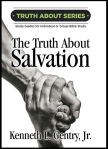 The Truth about Salvation By Ken Gentry
The Truth about Salvation By Ken Gentry
A study guide for personal or small group Bible study. Deals with the Christian doctrine of salvation from a Reformed theological perspective. It opens with a study of God as loving Creator, the shows how the first man fell into sin. Shows God’s righteousness requires that sin be dealt with. Presents Jesus as both God and man so that he can be man’s Savior. Includes review questions and questions for further study.Twelve chapters are ideal for one quarter of Sunday School.
See more study materials at: www.KennethGentry.com
Jesus’ Physical Resurrection
Indeed, the New Testament provides abundant evidence for Jesus’ physical, bodily resurrection from the dead. We can see this evidence in Scripture on at least fourteen occasions and by various persons. He was either visibly seen (by man) or authoritatively declared (by angels) to be raised from the dead as we see from the following:
• The angel(s) declared him as risen from the dead at the empty tomb (Matt. 28:5–6; Mark 16:5–6)
• Mary Magdalene saw him (Mark 16:9; John 20:14)
• Several unnamed women saw him (Mark 16:1–8; Matt. 28:9–10; Luke 24:1–11)
• Two disciples on the Emmaus road saw him (Mark 16:12–13; Luke 24:13–35)
• Ten of Jesus’ original disciples in the upper room saw him (Luke 24:36–43; John 20:19–23)
• The eleven disciples (after Judas’ death) a week later saw him (Mark 16:14–18; John 20:24–29)
• Cephas (Peter) saw him (1 Cor. 15:5), and later preached on his resurrection in a body that did not suffer decay (Acts 2:25-32)
• James, the brother of Jesus, saw him (1 Cor. 15:7)
• The eleven disciples in Galilee saw him (Matt. 28:16–20)
• Seven disciples in Galilee saw him (John 21:1–14)
• The eleven disciples on the Mount of Olives saw him (Luke 24:44–53)
• 500 believers at the same time saw him (1 Cor. 15:6).
• The Apostle Paul saw him (Acts 9:1–9)
• The two angel(s) at the ascension declared him raised from the dead (Acts 1:10–11)
The Continuing Incarnation
In addition, this denial of the Lord’s continuing incarnation contradicts direct statements made in various places in Scripture. For example, consider just five examples (one of which I have already mentioned):
Colossians 2:9: “For in Him all the fullness of Deity dwells [katoikei, present tense] in bodily form.”
1 Timothy 2:5: “For there is one God, and one mediator also between God and men, the man Christ Jesus.”
1 Corinthians 15:4: “He was buried, and that He was raised on the third day. (“He was raised” is the perfect, passive of egeiro: egegertai, which means “he was and continues to be raised.”)
Acts 1:9-11 serves as a double witness to his continuing incarnation, for it speaks of his bodily ascension into heaven as well as his bodily return at the second advent: “And after He had said these things, He was lifted up while they were looking on, and a cloud received Him out of their sight. And as they were gazing intently into the sky while He was going, behold, two men in white clothing stood beside them. They also said, ‘Men of Galilee, why do you stand looking into the sky? This Jesus, who has been taken up from you into heaven, will come in just the same way as you have watched Him go into heaven.’” (Many other verses could be brought to bear on both of these concepts of ascension and return.)
The incarnation was a permanent addition taken on by the Son of God when he became flesh as the Son of Man (his favorite self-designation, which still applies even to him now in heaven, Acts 7:56; Rev. 1:13; 14:14). By his incarnation he is forever united with us as the God-man. He came to earth to take on a physical body (John 1:14; Heb. 2:14; 10:5), was crucified and died in his physical body (Matt. 27:32–56; Luke 23:34–45), and was resurrected in his physical body (Luke 24:39–43; John 20:25, 27; Rom. 8:11). These truths lie at the very core of the Christian faith as revealed in Scripture.

Blessed Is He Who Reads: A Primer on the Book of Revelation
By Larry E. Ball
A basic survey of Revelation from an orthodox, evangelical, and Reformed preterist perspective. Ball understands John to be focusing on the destruction of Jerusalem and the temple in AD 70. Insightful. Easy to read.
For more Christian studies see: www.KennethGentry.com
Then he ascended into heaven in his physical body (Mark 16:19; Luke 24:50–51; Acts 1:9–11; 2:33–36; Eph. 1:20; 3:20; 4:8–10; Col. 3:1; Heb. 1:3; 4:14; 10:12; 1 Pet. 3:22; cp. John 3:13; 6:62; 20:17). Consequently, he is there at God’s right hand currently interceding for us as the incarnate Son of God, our Mediator (Rom. 8:34; 1 Tim. 2:5; Heb. 2:17–18; 7:25; 1 John 2:1). Then at the end of history (1 Cor. 15:25–26; 1 Thess. 4:13–17) he will return in his physical body (Matt. 16:27; Acts 1:10–11; Phil. 3:20–21) so that he may conduct the final judgment as a true man, the incarnate God-man (Matt. 25:31–33; Acts 5:22, 27; 17:31). Indeed, the Father “gave Him authority to execute judgment, because He is the Son of Man” (John 5:27; cp. John 5:22; Acts 10:42). He will be the judge because he is and will continue to be a man (Acts 17:31). After this, he will establish the eternal, physical new earth where we will dwell forever in righteousness (2 Pet. 3:10–13; Rom. 8:22–23). [1]
As B. B. Warfield put it: “the glory of the Incarnation is that it presents to our adoring gaze, not a humanized God or a deified man, but a true God-man — who is all that God is and at the same time all that man is.” And Albert Barnes well observed that “almost all heresy has been begun by some form of the denial of the great central truth of incarnation of Son of God” (comment at Col. 2:9). Hyper-preterism’s reinterpretation of his incarnate state, reducing it to a temporary experience by Christ, at least borders on this heresy.
Rhetorical Structure of 1 Corinthians 15:50–53
In fact, the neo-Gnostics hold that 1 Corinthians 15:50 teaches that we cannot enter into the eternal bliss of the kingdom of God with fleshly bodies: “Now I say this, brethren, that flesh and blood cannot inherit the kingdom of God.” Therefore, our “resurrection” must involve the disposal of our old material body in which we lived on earth, whereupon God will replace it with an altogether new and different “spiritual body.” This is a tragic misreading of what Paul is teaching here — and throughout 1 Corinthians 15.
Have We Missed the Second Coming: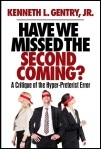
A Critique of the Hyper-preterist Error
by Ken Gentry
This book offers a brief introduction, summary, and critique of Hyper-preterism. Don’t let your church and Christian friends be blindfolded to this new error. To be forewarned is to be forearmed.
For more Christian educational materials: www.KennethGentry.com
It is important for us to recognize both the literary unit wherein we find verse 50, as well as its rhetorical point. As James Ware and others point out, 1 Corinthians 15:50–53 is a distinct literary unit in Paul’s argument against those who deny the idea of a resurrection (cf. vv. 12–19, 35–36a). And it is a well-crafted and highly structured rhetorical unit involving a concentric argument in an A-B-Aˈ pattern of synonymous parallelism. What is being argued herein?
As I will show more fully below, in (A) Paul points out a concerning, negative situation in the opening of the unit at verse 50. Here he presents a dangerous scenario for his proto-Gnostic opponents at Corinth. Then (Aˈ) he restates the matter, resolving the problem into a positive result at the end of the unit in verse 53. But in verses 51 and 52 (B) these opposing situations are connected chiastically by an important explanation. And in this explanation, verses 51–52 introduce the “mystery” of the change that will be effected at the resurrection and which will resolve the negative situation.
Let us first note how this is so, then consider the interpretive implications of Paul’s rhetorical argument. We will see how this supports the belief in our future physical, bodily resurrection as taught by the historic, corporate, public, universal, systematic Christian faith.
Schematic Analysis
As James Ware, John Gillman, Duane Watson, Margaret Mitchell, and others have shown, the A-B-Aˈ structure of the passage may be laid out schematically as follows, with bold type emphasizing the crucial features being linked:
A (v. 50): Now I say this, brethren,
a flesh and blood cannot inherit the kingdom of God;
b nor does the perishable inherit the imperishable.
B (vv. 51–52): Behold, I tell you a mystery;
c We will not all sleep, but we will all be changed;
d in a moment, in the twinkling of an eye, at the last trumpet;
dˈ for the trumpet will sound,
cˈ and the dead will be raised imperishable, and we will be changed.
Aˈ (v. 53) For [it is necessary that, Gk., dei gar]
bˈ this perishable must put on the imperishable,
aˈ and this mortal must put on immortality.
In the A statement (v. 50) we find the negative circumstance facing men: our current flesh and blood bodies cannot inherit (enter into, inhabit) the kingdom of God (i.e., the consummate eternal state of the redeemed in the presence of God). This is expressed by synonymous parallelism:
Flesh and blood > kingdom of God = perishable > imperishable
Similarly, Aˈ (v. 53) presents another synonymous parallelism:
perishable > imperishable = mortal > immortal
But in this case, the problem of A (v. 50) is solved by the situation presented in Aˈ (v. 53). For now the perishable and mortal put on imperishability and immortality. How can this be?
Paul explains this is the “mystery” (v. 51) [2] that allows flesh-and-blood men to enter into the glorious, consummate, eternal kingdom of God. He informs us in this transition passage (the center of the chiasm) that our perishable and mortal state will be changed by putting on the imperishable and immortal. This will occur at the resurrection on the last day, i.e., at the “last trumpet” (v. 52). [3]
So then, the “change” that will occur when “the dead will be raised” is that we will be clothed with (“put on”) imperishable, immortal bodies. We are not changed from flesh into spirit, for Paul states “for this perishable [body] must put on the imperishable, and this mortal [body] must put on immortality. But when this perishable [body] will have put on the imperishable, and this mortal will have put on immortality” (1 Cor. 15:54). This fleshly body laid in the dust is the same body of flesh that is to arise immortal.
[image error]For more information and to order click here.
" data-image-caption="" data-medium-file="https://postmillennialworldview.com/w..." data-large-file="https://postmillennialworldview.com/w..." class="alignright size-full wp-image-211" src="https://postmillennialworldview.com/w..." alt="" width="101" height="150" />Perilous Times: A Study in Eschatological Evil (by Ken Gentry)
Technical studies on Daniel’s Seventy Weeks, the great tribulation, Paul’s Man of Sin, and John’s Revelation.
See more study materials at: www.KennethGentry.com
We must recognize that this “change” comes by addition, not subtraction. It comes by our putting on a new quality, our adding to ourselves the glorious qualities of imperishability and immortality. We do not experience the subtraction of our physical nature. Our body will be raised miraculously by the almighty power of God as it is transformed from perishable to imperishable — not from physical to spiritual. For Jesus was the first fruits of the consummate resurrection (vv. 20, 23), and as noted above (and throughout the New Testament and Christian history), he was raised physically from the dead.
Thus, here in verses 50–53 the opening of the A stem (v. 50) speaks (“I say this”) to this issue, matching the opening of the Aˈ stem that declares “it must” be so. Here man’s predicament is introduced in the A stem negatively, warning that flesh and blood cannot inherit the kingdom, nor can the perishable inherit the imperishable. What then can be done? Again verse 53 answers that “this perishable must put on the imperishable, and this mortal must put on immortality.” Thus, the resurrection adds something (puts on imperishability, like clothing), rather than subtracting something (removing the physical body). And this is due to the mystery of the resurrection-change (vv. 51–52). The passage does not mention changing substance (flesh to spirit) but changing quality (mortal to immortal).
Notes
1. By the way, I know the maneuvers that the hyper-preterists have developed to re-interpret these passages to fit their scheme. Similarly, I also know the way that Jehovah’s Witnesses re-interpret verses that teach the deity of Christ and the Trinitarian nature of God. Any passage of Scripture can be taken outside the bounds of the Christian faith and re-worked to mean something altogether different. Sad, but true. As Peter warns, “the untaught and unstable distort … Scriptures to their own destruction” (2 Pet. 3:16).
2. In the New Testament, a “mystery” is something which requires a divine revelation from God in order to know or understand it.
3. As an important aside, note that we do not enter this new immortal, resurrected state at the moment of our death (as per DeMar and some other hyper-preterists), but at the “last trumpet” and as a corporate (simultaneous) action).
Openness Unhindered (by Rosaria Butterfield)
Dr. Butterfield goes to great lengths to clarify some of today’s key controversies. She also traces their history and defines the terms that have become second nature today-even going back to God’s original design for marriage and sexuality as found in the Bible. She cuts to the heart of the problems and points the way to the solution.
See more study materials at: www.KennethGentry.com
July 8, 2025
THE GOSPEL AND THE RESURRECTION
PMW 2025-056 by Kenneth L. Gentry, Jr..
In 1 Corinthians 15 Paul carefully and abundantly compiles a list of analogies that are important to understand. These underscore and accentuate the fact that our very mortal bodies in which we now live will be raised to new life and transformed into glory. Thus, he promotes a resurrection that involves continuity and discontinuity: continuity by involving the fleshly body in which we live on earth and discontinuity by enhancing the body’s power. He does so in such a way as to underscore and accentuate the truth that it is the “self-same body” that dies which is raised. And this is despite current-day neo-Gnostics in the hyper-preterist movement [1] who see our buried bodies as eventually being wasted away but that will be replaced with bodies composed of ethereal spirit material. Hopefully this theological fad will soon burn out and those caught up in it will repent and return to historic, orthodox Christianity.
A SUMMARY OF PAUL
In this regard, note the following summary analysis of 1 Cor. 15:36–41:
1. It is the God-designed goal of seeds to develop into plants, just as it is the God-ordained goal of our mortal bodies to be raised to immortal life (vv. 36, 38).
2. Just as in the botanical world, which serves as the source of Paul’s analogy, the very seed that is planted in the ground and dies in the earth will be raised to life again (vv. 36, 38).
3. The remarkable development of a living plant arising from a dead seed is a reflection of the miraculous power of Almighty God to raise our dead bodies at the resurrection (vv. 37–38).
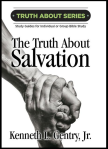 The Truth about Salvation By Ken Gentry
The Truth about Salvation By Ken Gentry
A study guide for personal or small group Bible study. Deals with the Christian doctrine of salvation from a Reformed theological perspective. It opens with a study of God as loving Creator, the shows how the first man fell into sin. Shows God’s righteousness requires that sin be dealt with. Presents Jesus as both God and man so that he can be man’s Savior. Includes review questions and questions for further study.Twelve chapters are ideal for one quarter of Sunday School.
See more study materials at: www.KennethGentry.com
4. Just like the barren seed planted in the earth eventually rises as a plant with beautiful flowers and leaves, so our mortal bodies planted in the earth will be raised and transformed into a state of magnificent glory at the resurrection (vv. 37–38).
5. Paul’s illustration of the differing kinds of flesh in the natural world (the flesh of men, beasts, birds, and fish) point to the different qualities of our physical flesh that we will receive in our final glorified, immortal, honorable resurrected state.
6. In his wisdom, God gives each seed the appropriate resulting plant (flower, tree, etc.), just as he gives to each of the astral bodies its own particular glory. Likewise at the resurrection our mortal physical bodies will be physically raised as glorious bodies designed for life in the consummate order (vv. 38, 40–41).
7. Finally, we should note that the visible glory of the sun, moon, and stars all prefigure God’s own glory (as often in the Old Testament), which glory will be granted to us, body and soul, as we finally enjoy the complete fullness of union with God in finality and perfection (vv. 40–41).
THE POWER OF GOD
In antiquity the idea of bodily resurrection of decomposed bodies was deemed philosophically and physically absurd. Some cultures believed in life after death, but not a physical, bodily life. Ancient philosophers would often deride the notion that a decomposed body consumed by animals could be reconstituted, made whole, and live again. They believed this on the basis of “the wisdom of the world” (which Paul warns against in his first four chapters).
[image error]Why I Left Full-Preterism (by Samuel M. Frost)
Former leader in Full Preterist movement, Samuel M. Frost, gives his testimony and theological reasoning as to why he left the heretical movement. Good warning to others tempted to leave orthodox Christianity.
See more study materials at: KennethGentry.com
But Jesus has responded to this extreme difficulty in Matthew 22 where the Sadducees are mocking him for his belief in a resurrection. Jesus’ response is the same we should give to the Gnostically-inclined preterists who deny a physical resurrection of the body: “You are mistaken, not understanding the Scriptures nor the power of God” (Matt. 22:29).
Similarly, in 1 Corinthians 15:35, the proto-gnostic problem at Corinth is presented in two questions: “But someone will say, ‘How are the dead raised? And with what kind of body do they come?’” Paul immediately begins his response with: “you fool!” (v. 36). To balk at the resurrection based on its supposed impossibility is foolishness in the eyes of God as Paul will prove in the following verses (as I have just summarized above).
Paul opens his letter with the warning that God has made foolish the wisdom of man (1:20). And now in 1 Corinthians 15 Paul reaches his goal in exposing the foolishness of man in light of the wisdom and power of God. The resurrection is the ultimate exposure of the foolish wisdom and knowledge of man who does not know the power of God. Some within the church at Corinth deny the resurrection and even its possibility, thus they “have no knowledge of God” so Paul must speak “this to your shame” (v. 34).
THE EVIDENCE AVAILABLE
We must remember four important contextual cues in 1 Corinthians 15:
First, the whole matter of the resurrection (beginning with Christ’s resurrection) lies at the heart of and is the foundation to the saving gospel of Jesus Christ (1 Cor. 15:3–4), which must be held fast or else their faith is in vain (15:1–2).
Second, the resurrection of Jesus was a physical resurrection of his body that could be touched, because it has “flesh and bones” (Luke 24:39) and it left behind an empty tomb (John 20:1–2) where it was laid (John 19:40–42).
God’s Law Made Eas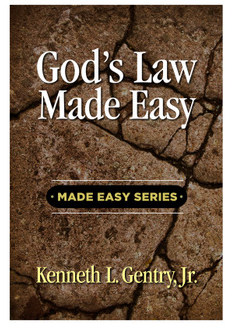 y
y
(by Kenneth Gentry)
Summary for the case for the continuing relevance of God’s Law. A helpful summary of the argument from Greg L. Bahnsen’s Theonomy in Christian Ethics.
See more study materials at: www.KennethGentry.com
Third, Paul reminds the Corinthians that they know Jesus was physically resurrected because they have the testimony of Cephas (Peter), James, and all the apostles (1 Cor. 15:5–7). And he appeared to 500 brethren at one time, of which most of them are still alive and could be contacted for confirmation by the Corinthians (15:6).
Fourth, Jesus’ resurrection is the “first-fruits” that promise our own like resurrection (1 Cor. 15:20, 23). And just as the first-fruits of a wheat harvest betoken a full wheat harvest of the same nature and kind, so Jesus’ resurrection assures us of our own like resurrection.
Furthermore, we must note that Paul insistently declares that it is the deceased body that is raised to new life, not a different body given to the deceased soul of the departed:
“For THIS perishable must put on the imperishable, and THIS mortal must put on immortality. But when THIS perishable will have put on the imperishable, and THIS mortal will have put on immortality” (1 Cor. 15:53–54).
Despite the neo-Gnostics among us today, there will be a corporate (not individualistic) resurrection of the bodies of believers at the return of Christ at the end of history. And that body will be a physical body that is raised and transformed into a glorious body — for “the Lord Jesus Christ … will transform the body of our humble state into conformity with the body of His glory, by the exertion of the power that He has even to subject all things to Himself” (Phil. 3:21).
NOTE
1. By “hyper-preterist” I am not narrowly referring to those who call themselves “full” preterists. Rather I am referring to anyone who follows the “full preterists” in denying the three R’s of eschatology: the denial of the future, physical Return of Christ, the future, physical, corporate Resurrection of the body, and the ultimate glorious Renewal of the created order. The hyper–preterist movement is in much disarray today, even debating among themselves what they believe. We must understand that it is the KEY issues involved that are heretical and crucial to understand. It is not each-and-every point of those who originally called themselves “full” or “consistent” preterists. Some are trying to escape the onus of heterodoxy pointed out by orthodox believers and are tinkering with their publicity machine. However, some gladly defy historic biblical orthodoxy, by teaching such things as we will even sin in heaven, because this is our nature (our sin was not caused ultimately by Adam). For instance, see: https://www.reformation.blog/p/how-shall-we-then-live-doesnt-matter
Dispensational Distortions
Three Lectures by Kenneth Gentry. Reformed introduction to classic dispensationalism, with analysis of leading flaws regarding the Church, kingdom, redemptive history, and Christ. Helpful for demonstrating errors to dispensationalists.
See more study materials at: www.KennethGentry.com
July 4, 2025
DEMAR’S CRITIQUE OF GENTRY
PMW 2025-055 by Kenneth L. Gentry, Jr.
On May 15, 2025 Gary DeMar (my old RTS classmate, friend, fellow-conference speaker, and publisher of several of my books) published an article about me that does not make sense: “Why Ken Gentry Must Oppose Full Preterism.”
DeMar’s opening charge
“Ken Gentry keeps changing his views about preterism. That’s OK because we all make changes. I believe his charges are designed to avoid having to deal with challenges to the partial preterist position.”
I must note up-front that Gary is correct. As I study the issue more carefully, I discover that I have made some exegetical oversights and argumentative mistakes in the past. However, I would note that though I have changed some of my arguments within preterism, my overall theology has not changed. I still remain fully within the flow of historic, orthodox Christianity (as reprehensible as that may sound to some).
Changing one’s understanding of certain texts of Scripture within one’s system is not necessarily harmful. However, changing one’s doctrinal positions on key issues defining historic Christianity is! Ironically, I still hold to the American Vision Statement of Faith (which is fully orthodox and reflects the position within the historic creeds of Christianity), whereas Gary as Senior Fellow of American Vision does not. Consider the following:
Have We Missed the Second Coming: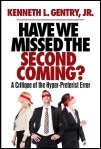
A Critique of the Hyper-preterist Error
by Ken Gentry
This book offers a brief introduction, summary, and critique of Hyper-preterism. Don’t let your church and Christian friends be blindfolded to this new error. To be forewarned is to be forearmed.
For more Christian educational materials: www.KennethGentry.com
The AV Statement of Faith reads:
“We believe in the personal, bodily return of our Lord Jesus Christ at the consummation of history. The dead, consisting of believers and non-believers, shall be raised up in final judgment. Those who are saved shall be raised up unto everlasting life and those who have rejected Christ unto eternal damnation.”
I also hold to what AV declares is the gospel, on its Internet site: “What is the Gospel” (https://americanvision.org/what-is-the-gospel/). A part of that statement reads:
“At the general resurrection of all men, when Christ returns in glory for the Final Judgment of the world, believers are resurrected in redeemed bodies, glorified like unto the Savior, acknowledged and acquitted by Him, and enter into the holy, happy, and eternal life of God’s consummated kingdom.”
I fully affirm each of these statements. And I affirm them in their original intent, without equivocating on their historic meaning. Though Gary once held to each of these doctrinal positions (and his ministry still claims to do so), unfortunately, he no longer does. He has not simply changed arguments within his doctrinal system but has changed his doctrinal system itself. His current doctrine is no longer fully orthodox.
Gary claims my changes within my argument are “designed to avoid having to deal with challenges to the partial preterist position.” I really need to go to another psychologist. Apparently my current psychologist has been reporting to Gary what I am thinking deep down within (because I certainly have not stated such in my writings or lectures). I knew I should have gotten a new psychologist when I told my current one that I was contemplating suicide and he responded by saying I need to start paying for sessions up front! And to add insult to injury, I told my psychologist I wanted a second opinion, and he simply put a sock-puppet on his hand and repeated himself.
Actually, changes that I have made in my preterist argument, to the contrary, are designed to respond to legitimate challenges to certain errors made within some of my writings. I am not attempting to avoid challenges to partial preterism as such, which I still hold. (By the way, “partial preterism” is a hermeneutic approach to certain texts of Scripture; “hyper-preterism” is whole, new theological system, which is unorthodox.)
Olivet Discourse Made Easy (by Ken Gentry)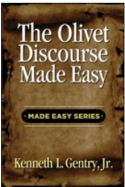
Verse-by-verse analysis of Christ’s teaching on Jerusalem’s destruction in Matt 24. Shows the great tribulation is past, having occurred in AD 70, and is distinct from the Second Advent at the end of history. Provides exegetical reasons for a transition from AD 70 to the Second Advent at Matthew 24:36.
See more study materials at: www.KennethGentry.com
John Lightfoot
For some reason (I have not been able to wrestle it out of Gary’s psychologist, so I really don’t know why), Gary brings up my admission that I wrongly classified Lightfoot as being a “preterist.” And this is the first thing he brings up in his critique of me! He writes:
“Let’s begin with his claim that John Lightfoot was not a preterist even though he said in the past that Lightfoot was a preterist.”
Well, so what? But as a matter of definitional fact, Lightfoot was an historicist. Historicism necessarily allows some preterist positions within because it is dealing with history stretching from the first century all the way to the end of history. But I dealt with this fully enough in my previous posting, so I won’t go into this irrelevant matter any further.
My commentary on Revelation
Gary writes:
“Gentry’s two-volume commentary breaks with the preterist-historicist approach like no other commentary has. It’s nearly a full preterist commentary, and that’s a problem for Gentry.”
That is simply a mistake. It is not nearly a full preterist commentary. I whole-heartedly reject full preterism and affirm the second coming of Christ, the corporate physical resurrection of the dead, and the final judgment within my commentary. Since it is a preterist commentary, hyper-preterists will almost certainly find things in it that they will appreciate. But they also will vehemently reject other portions of it. I don’t have a problem. Gary and hyper-preterists have a problem — with the historic Christianity to which I am committed.
As a matter of fact, though, I declare in my exposition of Revelation 1:7:
“I will be arguing more fully in Excursus 3 that 1:7 refers to AD 70. I would point out, however, that Israel’s judgment in AD 70 parallels and rehearses the larger-scale second advent and universal judgment at the end of history (cf. discussion in Excursus 15 at 20:1). Indeed, it is a microcosmic anticipation of the macrocosmic consummation. As Bloesch (84) puts it: ‘The catastrophe that befell the Jewish people in A.D. 70 is a sign of the final judgment.’ So if we properly understand AD 70, we see that “the fate of Jerusalem is an anticipation of the last judgment. The same fate which befell Jerusalem will, on a much vaster cosmic scale, embracing the whole world, overtake the Gentiles.”
Elsewhere, Gary scoffs that I spend twenty pages arguing that Rev. 1:7 points to the destruction of the temple in AD 70 and does not deal with the Second Advent as most evangelicals believe. But as just noted, I alert my reader that though this one verse does not teach what they believe it does (at least not directly), I do hold to a future, visible, physical second coming of Christ. No hyper-preterist, full-preterist, consistent-preterist, non-full-stop preterist, or whatever they are calling themselves today will agree with this note. Or any of my many other affirmations of the Second Advent.
Postmillennialism Made Easy (by Ken Gentry)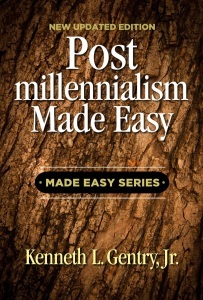
Basic introduction to postmillennialism. Presents the essence of the postmillennial argument and answers the leading objections. And all in a succinct, introductory fashion.
See more study materials at: www.KennethGentry.com
The Mello melodrama
Gary complains:
“Why has Gentry changed his view of the Greek word mellō that he used to defend the pre-AD 70 date of Revelation?”
I have changed it because as I began to realize no major New Testament translation translated it as “about to” in Rev. 1:19, I thought I had better double-check the matter.
I have explained this lexical and syntactic gaffe on my part. I have explained it fully enough on my website (though on another verse). See: “Hyperpreterism and Mello in Acts” .
And also see my two articles on “Resurrection, Paul, & Acts 24:15: (https://postmillennialworldview.com/2022/02/18/acts-2415-and-the-resurrection-1/) (https://postmillennialworldview.com/2022/02/22/acts-2415-and-the-resurrection-2/)
Ironically, I was making the argument for (partial) preterism stronger by removing a Greek exegetical error on my part. The Bible translation committees that agreed that mello was simply referring to a future that was certain, rather than a future that was near, presented their translations based on tried-and-true linguistic, syntactical, lexical, and historical analysis. Mello sometimes means “about to” but at other it means “certain to come.” Jason Bradfield carefully answers this matter in his article “Mello and the Real Bias Problem” (https://www.reformation.blog/p/mello-and-the-real-bias-problem) I highly recommend subscribing to Bradfield’s blogsite. As a former hyper-preterist he has studied the matters more than most; and he has the academic acumen to deal with the issues.
(Ironically, I am praying that Gary will mello with age, and return to Christian orthodoxy.)
Matthew 24:27
Gary complains: “Did Gentry change his interpretation of Matthew 24:27 to avoid falling off the full preterism precipice?” He asks: “How does Gentry’s interpretation square with Matthew 24:34?”
That’s easy to answer: No! I simply noticed a contextual matter that I had overlooked. I explain v. 27 in my latest Olivet Discourse Made Easy:
“The Lord cautions his disciples: “If therefore they say to you, ‘Behold, He is in the wilderness,’ do not go forth, or, ‘Behold, He is in the inner rooms,’ do not believe them” (Matt 24:26). We must recall Josephus’ report in Jewish Wars 2:13:5 [261–62] cited above that recorded an episode in which an Egyptian false prophet arose in the wilderness claiming a great deliverance.
Jesus dismisses such by stating that when he physically comes again to the earth, it will be an unmistakable event: “For just as the lightning comes from the east, and flashes even to the west, so shall the coming of the Son of Man be” (Matt 24:27). The “for” (gar) here shows that he is giving the reason why his disciples should not think he is off in some wilderness or in an inner room somewhere. When he does return it will be as visible and dramatic as lightning flashing.”
Carefully examining the overlooked context moved me to make this change — and this was initially prompted by noting R. T. France’s argument in his world-class, 1100-page exegetical commentary on Matthew in Eerdmans’ New International Commentary on the New Testament! This is an aside statement that Jesus engaged as a warning for his disciples. They must not make the mistake of thinking Jesus’ literal second coming was to occur in the first century like the deluded Jewish false Messiahs might try to lead them to think.
Conclusion
There is more that I could say; and I will be stating much more as I continue working on the Olivet Discourse and preterism. But again: I we be firing my psychologist for letting out my deeply-held inner secret fear of hyper-preterism. I should have gone to a confessional booth where he would not have seen me and known who I am. Gary may say that he is just “asking questions” as he grills the historic, orthodox Christian faith. But I wish he would answer questions. Just three questions: the one’s Andrew Sandlin and others put to him. See: https://postmillennialworldview.com/2023/03/02/concerns-re-gary-demar/
Thine Is the Kingdom
(ed. by Ken Gentry)
Contributors lay the scriptural foundation for a biblically-based, hope-filled postmillennial eschatology, while showing what it means to be postmillennial in the real world.
See more study materials at: www.KennethGentry.com
July 1, 2025
WAS LIGHTFOOT A “PRETERIST”? AGAIN.
PMW 2025-053 by Kenneth L. Gentry, Jr.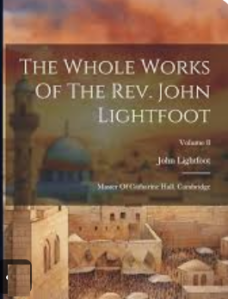
My mistake
I am returning to a thought that I had written on previously on my Postmillennial blogsite: I am explaining why I no longer hold that John Lightfoot of the Westminster divines was a preterist. I do this because Gary DeMar for some reason rebukes me for changing my understanding of Lightfoot. In a post on the American Vision website, DeMar asks: “Why is Gentry dismissing an author like Lightfoot whose works are filled with preterist arguments?”
I would note in the first place that I am not “dismissing an author like Lightfoot”! I admire and appreciate Lightfoot as a great Reformed scholar and remarkably brilliant Hebraist.
What I am doing, however, is correcting my mistaken view that he should be deemed a “preterist.” I was vigorously challenged by several actual historicists in my assertion that Lightfoot was a “preterist.” Technically, he was an historicist. But being an historicist does not prohibit applying certain prophecies to AD 70. This is because historicism looks at biblical prophecy as speaking of future history all the way to the second coming of Christ. And all future history from John’s time includes AD 70. Even dispensationalists can be preterist in certain portions of Scripture, without being classified as “preterists” (C. Marvin Pate is a very clear example of such).
I made my preterist assertion because of Lightfoot’s interpretation of the Olivet Discourse is strongly preteristic, and his allusion to Revelation 1:7 made in his Olivet study was preteristic.
THE APOCALYPSE OF JOHN
by Milton S. Terry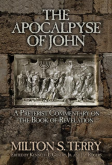
This book is Terry’s preterist commentary on the Book of Revelation. It was originally the last half of his much larger work, Biblical Apocalyptics. It is deeply-exegetical, tightly-argued, and clearly-presented.
For more study materials: https://www.kennethgentry.com/
My correction
But my previous declaration that Lightfoot was a “preterist” cannot be maintained due to his fuller exposition of the Book of Revelation. No “preterist” would hold to views that major portions of Revelation repeatedly speaking of distantly future history — not just one or two times, but repeatedly. But clearly, in Lightfoot’s view the majority of Revelation applies well-beyond the first century, and even beyond the fall of the Roman empire.
Consider the following statements from Lightfoot’s The Whole Works of the Rev. John Lightfoot (vol. 3). You can find Lightfoot’s work and read it at:
https://books.google.com/books?id=wgIUAAAAQAAJ&pg=PA415#v=onepage&q&f=false
There in his Introduction to Revelation (3:331), Lightfoot writes: “Christ [reveals] to ‘John, the beloved disciple,’ the state of the church, and story in brief, of her chief afflicters, from thence to the end of the world.” What “preterist” would make such a statement in introducing Revelation?
Of the trumpets vision he states (pp. 337–38): “the seven trumpets, under the seventh seal, give us a prospect, in general, of the times thenceforward, to the end of all things.”
Revelation 9 contains “a description of the Papacy, under the fifth trumpet” (p. 340).
pp. 341–42 on the sixth trumpet: “The Turks and Mahometans, coming as a plague upon the eastern part of the world, as the Papacy on the western. These hurt with their tails [false doctrine], as well as the other did in the former trumpet…. These hold out another head and saviour, — Mahomet.” Muhammad was not born until about AD 570.
The Divorce of Israel: A Redemptive-Historical Interpretation of Revelation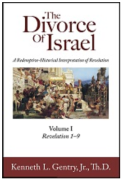
This long-awaited commentary has now been published. It is an 1800 page, two-volume deeply exegetical, academic commentary on the Bible’s most mysterious book.
Click: https://www.kennethgentry.com/the-divorce-of-israel-2-vols-by-gentry-pre-publication-offer/
See more study materials at: www.KennethGentry.com
p. 343 on Revelation 11
“John is commanded to leave out the court, which is without the temple, and not to measure it, ‘Because it was given to the Gentiles, and they should tread the holy city forty-and-two months.’ Not in a hostile was, but as the flock of the Lord tread his courts, there worshipping him; as see the phrase, Isa. 1.12; Psal. cxxii.2: and the meaning seemeth to be this, — ‘Measure not the court of the Gentiles; for their multitudes that come to attend upon the Lord, shall be bo endless and numberless.”
This understanding is the exact opposite of what a preterist would hold. We believe the Apostle John is referring to the destruction of the temple.
p. 346 on Revelation 12
On p. 346 Lightfoot writes regarding Revelation 12: “As Daniel giveth a general view of the times, from his own days, to the coming of Christ. . . so doth our Apocalyptic here, and forward. He hath hitherto given a general survey of the times from his own days to the end.”
p. 348 on Revelation 13
“The Holy Ghost, by Daniel, shows the four monarchies, the afflicters of the church of the Jews till Messias’s first coming, — the Babylonian, the Mede-Persian, the Grecian, and the Syro-Grecian: and John now takes at him and shows a fifth monarchy, the afflicter of the church of Jews and Gentiles till his second coming.”
p. 357 on Revelation 17
“Mystical Babylon” is “Rome [the Roman Catholic Church] so called, as being the mother of idolatry . . . made havoc of the church continually. . . . Rome, under the Papacy, was not the same Rome it had been, — and yet it was: not heathen and imperial Rome, as it had been before; and yet, for all evil, idolatry, persecution, &c, the same Rome to all purposes.”
Conclusion
I am thankful for the several preteristically-helpful passages in Lightfoot. But I can no longer deem him to be classified as a preterist. But he does offer some powerful arguments for Olivet being interpreted preteristically. And for John’s writing Revelation in AD 66. Yet, holding to an early date for Revelation does not make one a preterist either.
P.S.
In my next posting I will interact with other issues DeMar brings up in his critique of my arguments.
Great Tribulation: Past or Future?
(Thomas Ice v. Ken Gentry) 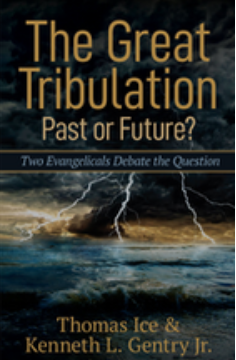
Debate book on the nature and timing of the great tribulation. Both sides thoroughly cover the evidence they deem necessary, then interact with each other.
See more study materials at: www.KennethGentry.com
June 27, 2025
NEW LEXICON SUPPORTS PRETERISM!
PMW 2025-052 by Kenneth L. Gentry, Jr.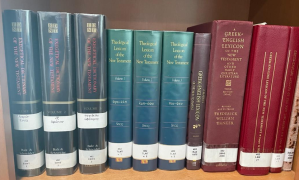
Introduction
The academic world has recently released a new, updated Greek-English lexicon that is certain to replace the standard lexicons currently in use today. Research in ancient Greek continues unabated at major research universities, with more powerful research tools providing deeper insights into ancient culture and language. And this one will surely displace the universally accepted standard lexicons, such The Liddell-Scott-Jones Lexicon, Thayer’s Greek-English Lexicon, and the Bauer-Danker-Arndt-Gingrich Greek-English Lexicon.
The current batch of Greek-English lexicons has proven helpful to scholars for years. But some academic questions remained as linguistic hurdles impeded fully understanding the Greek, especially New Testament Koine Greek. Now we are witnessing a major upheaval with this publication of the latest, upgraded lexicon, which is invested more strongly in AI-enhanced research.
This new lexicon is called, quite appropriately, New Lexicon of the 21st Century and Beyond. And it certainly will be a tremendous boon for scholars — especially for preterist scholars, as we will see. Plus with the new layout and 100% computer-generated text, the cost of this lexicon will fall well below those currently available — perhaps even 50% less. Let me explain how this can be in this review.
The Lexicon’s first advantage
In the first place, according to the publisher, this lexicon reduced the number of scholars involved in the project. This move helped lower up-front research costs, reduced time consumption, removed unpleasant and disorderly editorial debates, and increased the number of sigla (which itself saved much typographical space).
The Beast of Revelation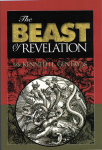
by Ken Gentry
A popularly written antidote to dispensational sensationalism and newspaper exegesis. Convincing biblical and historical evidence showing that the Beast was the Roman Emperor Nero Caesar, the first civil persecutor of the Church. The second half of the book shows Revelation’s date of writing, proving its composition as prior to the Fall of Jerusalem in A.D. 70. A thought-provoking treatment of a fascinating and confusing topic.
For more study materials, go to: KennethGentry.com
This new lexicon has become especially important since recent biographical and genealogical research uncovered some unfortunate, long-hidden truths. Most notably, research has discovered that the alleged editors of the standard lexicon of today, were not really Walter Bauer, W. F. Arndt, F. W. Gingrich, and Frederick William Danker, as advertised on the title page. This should have been expected due to the numerous errors that have been troubling Internet chatroom inhabitants of late.
Rather, it has been proven that the editors of BAGD were three men, not four! And their actual names were Mo Howard, Larry Fine (whose real name was Feinberg), and Curly Howard. And despite being Jewish, they were not able to spend an adequate amount of time in research and study of ancient languages and culture (which some consider to be advantageous for developing a lexicon, though such effort may be over-rated and actually cost-ineffective).
In fact, these three editors of BAGD spent most of their time in physical altercations arguing, yelling, slapping, smacking, and poking one another. And these interactions would often result in striking each other with mallets, 2×4 boards, chairs, baseball bats, golf clubs, table legs, doorknobs, broomsticks, mops, phones, pistols, shoes, hats, helmets, belts, rocks, boat oars, machetes, water buckets, ice cubes, a slab of meat, coffee pots, books, plates, sickles, knives, axes, pliers, chisels, crowbars, car jacks, shovels, mallets, pry bars, wrenches, bricks, chains, dumbbells, cue sticks, beer bottles, mallets (as you can see, they often used mallets, hence the reduplication in this listing), radios, saws, screw drivers, and scissors — to name just a few items they weaponized. (Be aware, for research reasons I had to watch 32 hours of Three Stooges shorts to get this list — and it may not even be complete!) These actions caused injuries ranging from minor blemishes to deep wounds caused by severe blows leaving each of them frequently battered and broken. Such actions caused medical costs in the editing process to soar.
In an important televised interview for National Geographic, the grandson of Mo admitted in 1982 that not one of the three editors even realized that our word “alphabet” was simply the combination of the first two letters of the Greek alphabet: alpha and beta. They thought it was just a cute sound that seemed to fit the need if one were asked to talk about the system of written symbols that could represent the sounds of a language, allowing it to represent spoken words in written form. That, and nothing more.

The Book of Revelation Made Easy
(by Ken Gentry)
Helpful introduction to Revelation presenting keys for interpreting. Also provides studies of basic issues in Revelation’s story-line.|
See more study materials at: www.KennethGentry.com
Instead of multiple and fraudulent editorship, only one scholar compiled the New Lexicon of the 21st Century and Beyond. His name is Larry Smith, who for the last three years has been youth pastor of the Momentum Church in Neptune, Tennessee. Momentum Church, as you can tell from its ridiculous name, is a non-denominational congregation (even though it follows the standard marketing practice of contemporary American churches: adopt all Baptist doctrines and practices, and merely drop the name “Baptist” from its sign, which will increase visitorship by almost 8.4%.)
The Lexicon’s second advantage
In the second place, we must notice something significant about this new, updated lexicon: its size. This will surely impress the academic world and speed up technical Greek translation and research. For instance, no longer will scholars be forced to wield and thumb through the Bauer-Arndt-Gingrich-Danker Lexicon’s cumbersome 1108 pages of 7.5 x 12 inch size, set in 7 point font laid out in double columns, and weighing in at a hefty 5 lb. and 6.1 oz. — even in its shrink-wrapped, case bound laminated hardcover edition.
Instead, the New Lexicon of the 21st Century and Beyond will be only 25 pages long, with pages only 5.5 x 8.5 inches in size, surrounded by one inch margins all around, and set in an easy-to-read 20 point Calibri, sans-serif type-font! And five of those pages contained only pictures, with four of those pages showing a different Greek letter expanded to a 7.5 inch height (though not in color, unless you count black as a color). Pastor Smith chose his four favorite Greek letters to exhibit in an enlarged size. The other page showed a picture of Pastor Smith’s two youngest grandchildren, both of whom look kinda Greek (except for their blond hair and blue eyes). What’s not to like about portability and the reduction of muscle strain encouraged by size and weight reduction? But how did they do this for the whole New Testament Greek text?
The Lexicon’s fourth advantage
I will skip to the fourth advantage since I have forgotten the third. In the fourth (and perhaps most important) place, the compiler of this New Lexicon of the 21st Century and Beyond has an advantage on all preceding Greek scholars: he was not encumbered with all the traditional expectations regarding lexical research and analysis. He avoided such by never actually studying Greek. In fact, he never reads books at all, and he does not know history very well. Thus, when he goes to a historical movie, he is always surprised at its ending. When he saw the movie Pearl Harbor, he was as shocked as were the original sailors and airmen on that fateful day.
Instead, Pastor Smith took a much simpler, more up-to-date route: he simply talked with a pastor-friend who knew someone who had visited Greece recently. This allowed him to take a fresh approach which did away with all the alternative entries for each of 5,437 different words in the New Testament. Let me explain.
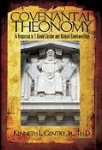
Covenantal Theonomy
(by Ken Gentry)
A defense of theonomic ethics against a leading Reformed critic. Engages many of the leading objections to theonomy.
See more study materials at: www.KennethGentry.com
No longer must the user of a lexicon have to fumble through page after page of differing definitions and competing applications of the Greek words found in the New Testament: they have all been removed and placed with one-concept definitions that work in every New Testament passage! Think of the time that will be saved as earnest pastors, scholars, and website hosts can now quickly find what they are looking for without expending all the energy, thought, and care previously required.
For instance, the word mello is one Greek word that has been useful for creating a whole new theology, so that we can toss out 2000 years of orthodoxy. Really! One word can be that important! So then, under our sample word mello we read in current lexicons a whole host of definition options — as if people would use the same word in different ways! As a matter of fact, BAGD had under mello the following: “take place at a future point of time, to be subsequent to another event, be about to, be inevitable, be destined, to come in the future.” Not only so, but that lexicon encumbers usability by offering too many research notes proving the point!
But now Pastor Smith’s New Lexicon of the 21st Century and Beyond cuts through all the riff-raff. He notes that all the options for mello signify the same thing: “very soon,” “extremely close at hand,” “incredibly near,” “right now,” “right in front of you,” “why wait?,” “there is no tomorrow,” “relax it has already happened,” “Hey, look at this!”
Conclusion
I would encourage the purchase of this compact but effective lexicon as soon as possible. In fact, I would urge you to buy, purchase, acquire, get, obtain, gain, procure, secure, pick up, barter for, redeem it mello! But be careful to not do it “fast,” for that may not mean “move quickly,” but may mean you will “stick tightly” to something or “go without eating.” Nyuk! nyuk! nyuk!
GOODBIRTH AND THE TWO AGES
I am currently researching a technical study on the concept of the Two Ages in Scripture. This study is not only important for understanding the proper biblical concept of the structure of redemptive history. But it is also absolutely essential for fully grasping the significance of the Disciples’ questions in Matthew 24:3, which spark the Olivet Discourse. This book will be the forerunner to a fuller commentary on the Olivet Discourse in Matthew’s comprehensive presentation. This issue must be dealt with before one can seriously delve into the Discourse itself.
If you would like to support me in my research, I invite you to consider giving a tax-deductible contribution to my research and writing ministry: GoodBirth Ministries. Your help is much appreciated!
June 24, 2025
INTRODUCING GENESIS (2)
PMW 2025-051 by Kenneth L. Gentry, Jr.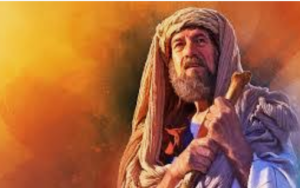
This is my second in a two-part, rather extensive series introducing Genesis. We now move on to consider its:
Genre
Moses was a gifted writer, as both the careful structure of Genesis as a whole and the exalted prose of Genesis 1 particularly testify. He was also quite capable of writing compelling poetry; in fact, and he did so frequently, both in Genesis (e.g., 2:23; 3:14–19; 12:1–3; 27:27–29; 49:2–27) and elsewhere (e.g., Exo. 15:1–8; Num. 6:24–26; Deut. 32:1–43; Psa. 90). But what is the basic genre of Genesis?
The content and structure of Genesis show that he wrote in narrative, historical prose. This is expected in that Israel possessed a factual, real-world oriented faith. As noted above, Genesis serves as the prologue to the Pentateuch. This is significant in that the Pentateuch is a lengthy narrative of the historical formation of Israel as a nation. Genesis would be useless for its purposes if we discount its historicity. Scholars do not doubt the basic historical nature of his genre in Exodus through Deuteronomy, even when they dispute its accuracy. And only a few scholars from critical schools of thought doubt his historical intent in Genesis 12–50. Nor do we have any evidence of a genre shift in the historical narratives from Genesis through the rest of the Pentateuch.
Genesis has a plot that leads the reader through its story-line development in historical fashion. The historically-rooted plot begins at the creation of the universe, the world, and man, the very foundation of history. Then it unfolds to the calling of Abraham, the expansion of his family, and eventually arrives at Israel’s sojourn in Egypt. Moses clearly wrote in a narrative prose style that assumed the historical character of the events he presented.
Thus, Moses carefully structured his material with an abundant use of waw-consecutives. The waw is the Hebrew letter that means “and.” This grammatical structure basically means “and then,” and therefore speaks of chronological development. Furthermore, his frequent use of genealogies speaks of historical descent: the ten toledoth (genealogy) markers (see above) developing his narrative demonstrate his clear historical intent. Israel’s history is not rooted in poetic myth but in historical fact. Consequently, it is not written in poetry but in prose.
Therefore, the Scriptures written after Genesis always deem the events within Genesis 1–11 to be historical facts. We may see this from many samples found in both Testaments. For example, 1 Chronicles 1:1; Job 31:33; and Hosea 6:7 mention Adam. First Chronicles 1 begins an extensive genealogy by citing from the Genesis genealogies beginning with Adam. Noah is mentioned in 1 Chronicles 1:4; Isaiah 54:9; and Eze. 14:14, 20. Psalm 104 is a hymn that follows the basic outline of Genesis 1 and mentions many of its elements in praising God as Creator.

As It Is Written: The Genesis Account Literal or Literary?
Book by Ken Gentry
Presents the exegetical evidence for Six-day Creation and against the Framework Hypothesis. Strong presentation and rebuttal to the Framework Hypothesis, while demonstrating and defending the Six-day Creation interpretation.
See more study materials at: www.KennethGentry.com
In the New Testament Luke cites from the genealogy including Adam and his offspring (Luke 3:38). The creation narrative in Genesis 1 and 2 is cited by Jesus as history (Mark 10:6–8). He mentions the murder of Abel (Matt. 23:35), Noah and the Flood (Luke 17:26–29), and Sodom and its character and destruction (Matt. 10:15; 11:23–24).
Paul deals extensively with Adam (Rom. 5:12–21; 1 Cor. 15:22, 45). He mentions Eve’s creation after Adam (1 Tim. 2:13) and her deception by the serpent (2 Cor. 11:3; 1 Tim. 2:13). John refers to Cain’s murder of Abel (1 John 3:12).
Other New Testament references to Genesis as history include Abraham’s history (Acts 7:3–5), Hagar (Gal. 4:22, 30), the age of Abraham and Sarah when she conceived (Rom. 4:19), Abraham’s willingness to offer up Isaac (Jms. 2:21), Sodom (2 Pet. 2:6; Jude 7), Rebekah’s conception of twins (Rom. 9:10), the flood (1 Pet. 3:20; 2 Pet. 3:6), Noah and the ark (Heb. 11:7; 1 Pet. 3:20; 2 Pet. 2:5), and more.
Creation in Genesis
Undoubtedly the most debated portion of the Pentateuch is the creation narrative(s) in Genesis 1–2. But it is simultaneously the most important part in that all else in world history, redemptive history, and the Bible depends on it. In fact, this may be the reason it is so strongly challenged by critical scholars.
Here in the opening of Genesis, Moses gives an account of the origin of the entire universe, the world which man inhabits, and man himself. Nothing could be more important to man than these issues. But Moses’s creation account runs counter to the prevailing mythology of our day: evolution. Therefore, it is vigorously attacked as primitive, naive, and even absurd. The modern mind rejects the supernatural creation of an orderly universe by a wise, powerful, and orderly God as nonsense in favor of a chance explosion from nothing 13.8 billion years ago.
Creation summary. As we read the creation account it becomes quickly obvious that it is a summary of God’s creative action, not a detailed presentation. For instance, though it is clear that God created the waters (since he created everything, 1:1), they are simply mentioned as existing in Genesis 1:2. Nor does it cover each of the plant or animal species, providing only a representative sampling of a few general classes of each. Nor are we told when the angels were created, though later in Genesis 3 the presence of a fallen angel appears.
Furthermore, the creation account is not a scientific account. It does not mention the electromagnetic properties of light or its speed in a vacuum (1:3), the rotation of the earth on its axis or its angular momentum (1:5, 8, 13), the hydrogen bonding process in water molecules or the gaseous components of the atmosphere (1:6), the operations of plate tectonics or the earth’s lithospheric flexure (1:9), the nature of photosynthesis or the respiration process in plant metabolism (1:11–12), the gravitational mechanics of the elliptical orbit of the earth around the sun or the differential force of gravity on a spherical body such as the moon (1:14), and so forth. It does not present these scientific facts; nor does it intend to do so; nor does it need to do so.
Nevertheless, though the creation narrative does not present science, it does present history. That is, it presents literal, historical facts regarding the main features of creation, the order in which they were created, and the amount of time involved in their creation. It is therefore like the resurrection accounts of Jesus: they present historical facts but not scientific explanations. They do not discuss the renewal of his brain stem activity, how the primary flaccidity of his body’s muscles was overcome, the beginning of the contraction and relaxation of his myocardium, the re-starting of independent respiration, the re-ignition of the metabolism processes, and so forth at his resurrection.
Yet, the Genesis creation account does report the God-created nature of reality (1:1) caused by God’s rational fiats (1:2, 6, 9, 11, 14, 20, etc.), its predictable recurring patterns of light and darkness (1:5, 8, 13, 19, 23, 31), the orderly nature of plant and animal reproduction (1:11–12, 21, 24–25), the divinely effected separations of creational features (1:4, 6, 7, 14, 18), the regularity of its seasons and years (1:14), the prospect of human control over creation (1:28), and so forth.
Reformed Eschatology in the Writings of Geerhardus Vos
Ed. by Ken Gentry and Bill Boney
This is a collection of several key eschatological studies by the renowned Reformed theologian Geehardus Vos. We have modernized Vos’ grammar and syntax and updated his layout style according to modern publishing conventions (shorter sentences and paragraphs). We did this without changing any of Vos’ arguments.
For more information on this new Vos work or to order it, see:
https://www.kennethgentry.com/reformed-eschatology-in-the-writings-of-geerhardus-vos/
Therefore, the Genesis creation account establishes the necessary pre-conditions of intelligibility and therefore the very foundations of science itself. The Genesis account of creation is not a science book, but it does make science possible.
Creation allusions. The creation account is not simply mentioned in Genesis 1–2 then forgotten. Ex nihilo creation by God is important to the whole biblical record and is frequently mentioned later. God is often called the “Creator” (Eccl. 12:1; Isa. 27:11; 40:28; 43:1, 15; Rom. 1:25; 1 Pet. 4:19). The fact of the six-day time-frame of creation is noted in Exodus 20:11 and 31:17, and Psalm 104 is a song of praise to God which follows each of the six days of Creation.
We see a few samples of the clear allusions to the creation account in the following verses.
Genesis 1:3, 6–7, 9, etc. = Psalm 33:8, 9; 148:5 (creation by spoken word)
Genesis 1:3 = 2 Corinthians 4:6 (creation of light from out of darkness)
Genesis 1:9 = Psalm 33:7; 104:8–9; Proverbs 8:29 (gathering of waters)
Genesis 1:14 = Psalm 74:16; 136:7 (sun created for light)
Genesis 1:14 = Psalm 104:19 (moon for seasons)
Genesis 1:16 = Psalm 136:7–9 (great lights to rule day and night)
Genesis 1:27 = Matthew 19:4; Mark 10:6; 1 Corinthians 11:7; James 3:9 (image of God)
Genesis 1:28 = Psalm 8:6–8 (man to subdue the earth)
Genesis 2:7 = Ecclesiastes 12:7; 1 Corinthians 15:47; Job 33:4; 1 Corinthians 15:45 (man returns to dust)
Genesis 2:8 = Genesis 13:10; Isaiah 51:3; Ezekiel 28:13; Joel 2:3 (garden of Eden)
Genesis 2:9 = Ezekiel 31:8–9 (trees in Eden)
Genesis 2:9 = Proverbs 3:18; 11:30; Revelation 2:7; 22:2, 14, 19 (tree of life)
Genesis 2:21–22 = 1 Timothy 2:13; 1 Corinthians 11:8–9 (man created before woman)
Genesis 2:24 = Matthew 19:4–6; 1 Corinthians 6:16; Ephesians 5:31 (two become one flesh)
So then, creation not only opens Scripture, it impacts it from beginning to end.
Creation and sovereignty. As noted earlier, Moses did not provide the creation narrative as a matter of mere human interest, as if he were simply filling out Israel’s knowledge base. Rather this revelation is given to Moses for Israel as something vitally important to her in her current historical circumstances. The creation narrative is given for practical reasons.
First, it explains that only one God exists. “In the beginning God” (1:1a). This is important in that Israel must remember that the singular, true and living God recently delivered her from a polytheistic land, Egypt (Exo. 12:12; 18:11). This understanding will be crucial as God soon will lead her into another polytheistic environment: Canaan (Deut. 4:28; 31:20). She must never forget that God alone is granting her the land he promised to her forefathers, Abraham, Isaac, and Jacob: “See, the LORD your God has placed the land before you; go up, take possession, as the LORD, the God of your fathers, has spoken to you. Do not fear or be dismayed” (Deut. 1:21; cp. Deut. 6:10–14).
Despite the temptations Israel will endure in the land, her creed must always be true to the God of creation: “Hear, O Israel! The LORD is our God, the LORD is one!” (Deut. 6:4).
Second, it indicates that God is distinct from creation. “In the beginning God created the heavens and the earth” (1:1). The phrase “the heavens and the earth” is a merism for the totality of all created things. The Canaanites saw the sun, moon, and stars, which Israel’s God had created (1:14–19), as deities themselves: “beware not to lift up your eyes to heaven and see the sun and the moon and the stars, all the host of heaven, and be drawn away and worship them and serve them, those which the LORD your God has allotted to all the peoples under the whole heaven” (Deut. 4:19; cp. Deut. 17:3).
Later, God will speak to Israel through Isaiah: “Lift up your eyes on high / And see who has created these stars, / The One who leads forth their host by number” (Isa. 40:26a). As Paul would eventually express the problem: “they exchanged the truth of God for a lie, and worshiped and served the creature rather than the Creator” (Rom. 1:25). Contrary to the Egyptian and Canaanite worldviews, the true and living God of Israel is transcendent, being above and distinct from creation as its absolute Creator.
Third, it demonstrates the great power of God. “Then God said, ‘Let there be lights in the expanse of the heavens to separate the day from the night, and let them be for signs and for seasons and for days and years’” (1:14). God created the sun, moon, and stars whom the Canaanites worshiped (Deut. 4:19; 17:3). The name “Elohim” is mentioned thirty-two times in Genesis 1; it is a name that emphasizes “might, power.” The creation narrative emphasizes God’s absolute sovereignty. Every verse in Genesis 1 has God as active, except for four, which simply report the passing of evening and morning (1:13, 15, 19, 23).
Predestination Made Easy
(by Ken Gentry)
A thoroughly biblical, extremely practical, and impressively clear presentation of
the doctrine of absolute predestination.
See more study materials at: www.KennethGentry.com
Therefore, Israel must understand God’s great sovereignty in creation so that she might serve only him (Deut. 3:24; 10:17). Her God is absolutely superior to the competing, warring gods of Canaan. Israel needs to understand this as she enters a land possessed by peoples mightier than she. “Hear, O Israel! You are crossing over the Jordan today to go in to dispossess nations greater and mightier than you, great cities fortified to heaven” (Deut. 9:1; cp. 11:23). Later she will sing his praises for this: “For He spoke, and it was done; / He commanded, and it stood fast” (Psa. 33:9; cp. 33:6; 148:5).
God alone is Creator, by his own power: “This is the account of the heavens and the earth when they were created, in the day that the LORD God made earth and heaven” (Gen. 2:4; cp. Rev. 4:11). Israel needs to recognize that “the LORD your God is the God of gods and the Lord of lords, the great, the mighty, and the awesome” (Deut. 10:17a). Consequently, he must be revered as “the Mighty One, God, the LORD, the Mighty One, God, the LORD” (Josh. 22:22a).
Fourth, it proves that God is a God of order and peace. “By the seventh day God completed His work which He had done, and He rested on the seventh day from all His work which He had done. Then God blessed the seventh day and sanctified it, because in it He rested from all His work which God had created and made” (2:2–3). Creation does not come about by a struggle between warring gods. The creation account explains that as each step of creation is completed, God declares it “good”: “God saw that it was good” (1:10; cp. 1:4, 12, 18, 21, 25). Thus, at the end of creation week, God could declare: “God saw all that He had made, and behold, it was very good” (1:31).
Fifth, it shows that God is over history as its Ruler. God is the one who created the mighty sun, the glorious moon, and the innumerable stars that govern night and day: “God placed them in the expanse of the heavens to give light on the earth, and to govern the day and the night, and to separate the light from the darkness” (1:17–18).
Thus, God is the absolute sovereign who must be feared, obeyed, and served in Canaan. “Then the LORD said to me, ‘Arise, proceed on your journey ahead of the people, that they may go in and possess the land which I swore to their fathers to give them.’ Now, Israel, what does the LORD your God require from you, but to fear the LORD your God, to walk in all His ways and love Him, and to serve the LORD your God with all your heart and with all your soul” (Deut. 10:11–12). Israel’s God is not extraneous to life, but the very Governor of it.
Sixth, it proves that Israel is related to the nations. Israel is elected by God and called for his special purpose: “The LORD said to Abram, / ‘Go forth from your country, / And from your relatives / And from your father’s house, / To the land which I will show you; / And I will make you a great nation, / And I will bless you, / And make your name great; / And so you shall be a blessing; / And I will bless those who bless you, / And the one who curses you I will curse. / And in you all the families of the earth will be blessed’” (12:1–3). Yet, she must not discount the nations as valuable in God’s sight.
Moses explains that all men are descended from Adam and Eve, the single pair whom God created in Eden. “God blessed them; and God said to them, ‘Be fruitful and multiply, and fill the earth, and subdue it; and rule over the fish of the sea and over the birds of the sky and over every living thing that moves on the earth’” (1:28). The first genealogy of Scripture is designed to specifically link the early human race back to Adam: “this is the book of the generations of Adam” (5:1). Knowing her relationship to the nations and God’s creative sovereignty over them should encourage her in her noble task.
Creation myths. Critical scholars see the Genesis creation account as rooted in ancient Near Eastern creation myths, such as Enuma Elish (Babylonian), the Atrahasis Epic (Akkadian), the Gilgamesh Epic (Akkadian), the Chaoskampf Myth (Canaan), and others. They often point to Enuma Elish as its specific source. The Enuma Elish myth was discovered in 1849 on clay tablets in Nineveh (modern Mosul, Iraq) and was quickly linked to Moses’s account due to certain similarities.
Some of the significant similarities between the Enuma Elish and Genesis accounts include: (1) Enuma Elish is recorded on seven separate tablets, and Genesis apportions its account into seven days. (2) Creation results from divine activity in both. (3) Both present a similar order of creation events, with water and darkness at the beginning (1:2). (4) The Hebrew word tehom (“deep”) in Genesis 1:2 seems related to the name of the ocean goddess Tiamat. (5) The naming of portions of creation is important in both accounts. (6) Both include the act of a separating of the heavens and the earth. (7) The “sea monsters” of Genesis 1:21 parallels the sea monsters in the Enuma myth. (8) Man is created by divine activity (1:28).
Thine Is the Kingdom
(ed. by Ken Gentry)
Contributors lay the scriptural foundation for a biblically-based, hope-filled postmillennial eschatology, while showing what it means to be postmillennial in the real world.
See more study materials at: www.KennethGentry.com
Consider the following responses to the similarities.
First, the historical expectation. We would expect some similarities to appear in ancient creation myths. This is because the Genesis account is a record of the original, true creation process. It would have been passed down to Adam’s descendants, though eventually it would have been corrupted due to sin and the increasing distance from the events.
Second, the polemical function. Moses seems to be presenting the creation account in a polemical fashion, setting the true origin of the world over against pagan conceptions. This would explain certain similarities. For instance, the Hebrew word tehom (1:2) is somewhat similar to the name of the goddess Tiamat. Yet, Moses specifically de-personifies it. What is more, the tehom in Genesis does not resist God, but is clearly under his Spirit’s control. In addition, the great “sea monsters” (Heb., tannin) of Genesis are not fearsome and destructive as in Enuma, but are a part of God’s “good” creation (1:21).
Moses refuses to name the sun (Heb., shemesh) and moon (Heb., yareah) because their names were the names of gods worshiped in Canaan. As a put-down he simply calls them the “greater light” and the “lesser light” (1:16). He also mentions the luminaries’s creation in reverse order, mentioning the sun and moon first. In Enuma the stars are given priority as special objects of worship and are followed by the sun and moon. Moses emphasizes the creation of the sun and moon, but mentions the stars as if an aside: “he created the stars also” (1:16). Besides all this, Moses’ emphasis on God’s creating these stellar lights clashes with Enuma’s presenting them as uncreated gods.
Third, the literary differences. The two accounts are not as similar in the fundamentals as critics suggest. The three most significant differences are: (1) Genesis is monotheistic, whereas Enuma is polytheistic. (2) In the Enuma myth the gods are not above and distinct from nature, but are a part of nature. (3) The Genesis creation process is orderly and peaceful, while the Enuma account involves struggle, war, and chaos. In fact, the Genesis creation proceeds by God’s orderly fiats, whereas the pagan account involves magical incantations that sometimes fail.
Though the creation events follow a similar order, the order is not exact. For instance, in Enuma light is not created before the sun (contra 1:3, 24). The Genesis account of the creation of light is rather stark and counter-intuitive.
In the myth, the heavens and the earth are formed on the fourth tablet, rather than in the first three days as per Genesis. In fact, in Enuma the sun is not created at all, and the creation of vegetation and animals is not mentioned, whereas in Genesis the whole world and all things in it are created. The pagan account has man created as a slave to the gods, rather than as the highest act of creation designed for fellowship with God.
The differences between the pagan conceptions of creation and the Mosaic account are fundamentally different. Compared to Enuma Elish and the other ancient Near Eastern myths, Moses presented to Israel a radical way of conceiving the world’s origin and man’s role in it. As Reformed Old Testament scholar E. J. Young (1907–1968) noted: “Genesis 1 is monumental in character, and exhibits a stately cadence of grandeur as it reveals the sovereign Creator uttering His will, and that will coming to immediate fulfillment.” Whereas the tale in Enuma is altogether bizarre.
The Mosaic account of creation is historical; and it is necessary to the message of Genesis. Israel’s God is sovereign and must be obeyed for he created history and governs it. Moses shows God’s sovereignty through his creating the world (chs. 1–2), his judging sin by cursing the world and life (chs. 3), his cursing it and beginning anew in Noah’s day (chs. 6–9), his confounding the nations by separating their languages (chs. 11), his gracious calling of Abraham to establish a distinct people to minister to the world (chs. 12), and his protection of Israel from destruction through famine (chs. 41–50). In his next book he will record Israel’s experience of God’s sovereignty as he redeems her from bondage to mighty Egypt by plagues and miracles (Exo. 7–15), the miraculous provision of manna (Exo. 16) and water from the rock (Exo. 17), and more.
The historical account of Israel (the focus of the entire Old Testament beginning in ch. 12) needs an historical account of her origins. So Moses traces her origins back through Noah to Adam.
June 20, 2025
INTRODUCING GENESIS (1)
PMW 2025-050 by Kenneth L. Gentry, Jr.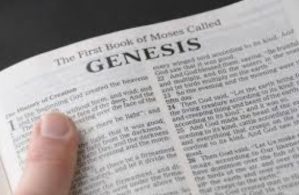
Title
Genesis is the first of the five books of Moses (the Pentateuch). The titles to the first five books of the Bible are actually the first words of the Hebrew text in each book. Thus, the Jews called the first book Bereshith, which is the first word in the Hebrew of Genesis 1:1. It means “by way of beginning, or in beginning.”
The title by which we today call this book is derived not from the first words of the Hebrew, but from its Septuagint title. The Septuagint title is directly transliterated as: Genesis. Each of the Greek titles of the Pentateuch summarize the subjects of the books, rather than presenting their first words. Had the ancient Greek translators used Genesis’s first words, it would have been called: En archē (“in beginning”). They apparently derived the title we use from Genesis 2:4a which reads: “This is the book of the generation [geneseos] of heaven and earth.” The Greek word means “origin, source, or generation.”
Author and Date
As noted in the “Introduction to the Pentateuch,” Moses apparently wrote all five of the books in the Pentateuch. And he wrote them in the order they appear in our modern Bibles (which is the order of the ancient Hebrew canon). Therefore, Genesis is its first volume.
We noted that Moses wrote the Pentateuch after the exodus from Egypt and before Israel entered the Promised Land. Therefore, Genesis itself was written sometime after 1446–1445 BC (the date of the exodus). This is as close as we can determine its date of composition with any confidence. Yet, if the Pentateuch was written as one book (see Josh. 8:31; 23:6 and “Introduction to the Pentateuch”), then it would have been written toward the end of Moses’s life. This would be necessary in that Deuteronomy is clearly written just before he dies (Deut. 34:1, 4–6; cp. Deut. 32:48–50).
Purpose
Genesis is a well-constructed historical work. It basically serves as the prologue to the record of Israel’s founding drama as a nation. In the Pentateuch she is being transformed from a small family into a great people and made ready to enter her own land to become a nation. This observation is based on the dominance of the family of Abraham in Genesis itself (chs. 12–50), on Israel’s ending up in Egypt where the drama begins (50:22–26), and on the narrative of the four books that chronologically follow Genesis (Exodus–Deuteronomy). Thus, after the foundational story-line established in Genesis, the main drama begins with Egypt’s maltreatment of Israel (Exo. 1:8–22), continues through her exodus from Egyptian bondage (Exo. 13), and leads ultimately to the border of the Promised Land (Deut. 34).
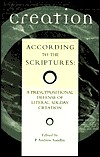 Creation according to the Scriptures
Creation according to the Scriptures
Ed. by P. Andrew Sandlin
This book is sub-titled: A Presuppositional Defense of Literal , Six-day Creation. It has chapters by R. J. Rushdoony, Andrew Sandlin, Kenneth Gentry, Cornelius Van Til, and others. It touches on historical, exegetical, theological, and philosophical implications of Six-day Creation.
See more study materials at: www.KennethGentry.com
As the early narrative of Genesis unfolds, immediately after the creation account (chs. 1–2), Moses traces the start and development of man’s moral degeneration beginning with Adam’s sinning against God’s bounteous goodness in Eden (3:1–7). But the good God of creation reveals his gracious promise of redemption (3:15) even in the context of his judgment on man and the world (Gen. 3:14–19; cp. Rom. 5:12; 8:20).
The record of man’s fall quickly results in inter-family murder in the first generation (Cain slays Abel, 4:8). Then in fifteen verses it moves to Lamech’s joyful singing of his killing a man (4:23). Then after a genealogical list linking Adam (5:1) to Noah (5:30–32), the story continues by showing that man’s wickedness becomes “great on the earth” so that “every intent of the thoughts of his heart was only evil continually” (6:5; cp. 6:11–12). This results in God’s worldwide judgment through the flood (6:13; 7:4, 10–12, 17–21). Even after God’s gracious sparing of Noah and his family (6:8) while judging the rest of mankind (7:1–4), however, men attempt to maintain social unity for evil purposes (11:6). This in turn leads God to confounding their languages so as to divide and scatter them with a view to reducing their power (11:4–8).
God then turns to another individual, Abram (a.k.a. Abraham, Gen. 17:5; Neh. 9:7). He calls him out of a pagan home and environment (Gen. 12:1; cp. Josh. 24:2) and promises him great blessings (12:3; 13:14–17; 15:7, 18; 17:1–2; 26:2–6; 28:10–15). With the call of Abraham, Moses begins tracing his family’s development through Isaac (25:19–26:35) to Jacob (27:1–37:1), then on to Joseph (37:2–50:26).
The Joseph account is emphasized because it shows how Abraham’s family ended up in Egypt where Israel was enslaved. Later Moses’s successor Joshua records God’s summary of Israel’s whole history (Josh. 24:1–13). He does this in exhorting her to “fear the LORD and serve Him in sincerity and truth; and put away the gods which your fathers served beyond the River and in Egypt, and serve the LORD” (Josh. 24:14).
Moses wrote Genesis to instruct Israel regarding her divine election by sovereign calling; he did this to encourage her to obey her covenant-making God. By opening with the creation account, Moses is not simply providing interesting information about cosmic origins. Rather he is setting Israel in the context of universal history. Israel is related to the whole human race which began with a single pair, Adam and Eve. The two genealogies in Genesis 5:1–32 and 11:10–32 are designed to link Abraham back to Noah, then through Noah to Adam, the father of the human race. As we shall see, this is important for Israel to know who she is and why she exists.
We must understand that the Pentateuch was specifically revealed to a particular people at a particular time for a particular purpose. It was given to fifteenth century BC Israel, and it was given to prepare her for entering Canaan, the land promised to Abraham by God’s gracious covenant (Gen. 12:1, 7; 13:15, 17; 15:7; 26:3; 28:13; Exo. 6:8; 32:13; Lev 26:42; Deut. 1:8; 6:10; 30:20; 34:4). Moses reminds Israel that she was elected by God (Gen. 12:2–3; Exo. 19:4–6; Deut. 4:37; 7:6–8; 10:14–15; 14:2) so that she might be a blessing to “all the families of the earth” (12:3; 22:18; 18:18; 26:4; 28:14). She was called to be “a kingdom of priests and a holy nation” in the world (Exo. 19:6). She was to keep God’s Law as an example to the nations that they might follow her, declaring: “surely this great nation is a wise and understanding people” (Deut. 4:6b). Thus, her calling was not due to God’s unconcern for the nations, but that she might be the conduit of his revelation and grace to them.
Four Views on the Book of Revelation
(ed. by Marvin Pate)
Helpful presentation of four approaches to Revelation. Ken Gentry writes the chapter on the preterist approach to Revelation, which provides a 50 page survey of Revelation .
See more study materials at: www.KennethGentry.com
In the books following Genesis Moses will emphasize that Israel’s God sovereignly delivered her as his chosen people by his great power: “Because He loved your fathers, therefore He chose their descendants after them. And He personally brought you from Egypt by His great power, driving out from before you nations greater and mightier than you, to bring you in and to give you their land for an inheritance, as it is today” (Deut. 4:37).
Israel must understand her God’s sovereignty so that she not fear the larger and stronger nations that she will encounter in the Promised Land (Deut. 7:1, 7). Therefore, Moses opens the Pentateuchal narrative with the revelation that her God created the entire world by his mere spoken word (1:3, 6, 9, 11, 14, 24). Not only so, but God created a good and peaceable world (2:7–15; cp. 1:29–30) — not the corrupt, warring, dangerous world Israel then experienced. Her God was a good and gracious Lord, unlike the evil gods of the nations (Gen. 15:11; cp. Exo. 34:15–16; Deut. 12:31; 20:18).
Israel must understand that man was tested by God in Eden (2:16–17; 3:11) and failed (3:1–7), bringing sin into the human race. This historical account of Adam’s testing and fall are given to provide a warning to Israel that she will be tested and must not fail (Exo. 15:25; 16:4; 20:20; Deut. 8:2, 16; 13:3). Tragically she did not learn the lesson (Deut. 29:26; 31:16, 18; 32:16–17).
Moses was calling Israel to trust in the true God and reject the false gods of Canaan where she will soon be living (Exo. 20:3, 23; 23:13–32; 34:15–17; Num. 25:2; Deut. 6:14; 7:16; 8:19; 11:28; 13:2–13). As we will see below, the Genesis creation account is written partly as a polemic against the false gods and the creation myths of the surrounding world of Israel. Therefore, Moses exhorts her to “know that the LORD your God, He is God, the faithful God, who keeps His covenant” (Deut. 7:9). And she must understand that “there is no other God besides Him” (Deut. 4:35; cp. Exo. 8:10; 9:14; Deut. 4:39; 32:39; 33:26).
In fact, his sovereignty over the gods of the nations will be demonstrated by his overthrowing Egypt’s false gods in the judgments against Egypt: “I will go through the land of Egypt on that night, and will strike down all the firstborn in the land of Egypt, both man and beast; and against all the gods of Egypt I will execute judgments—I am the LORD” (Exo. 12:12; cp. Exo. 18:11; Num. 33:4). As he informs Israel: “the LORD your God is the God of gods and the Lord of lords, the great, the mighty, and the awesome God” (Deut. 10:17).
Through all of this — and more could be said! — we see the extreme importance and the great value of Genesis for the whole rest of Scripture.
Importance
We have noted that both the Hebrew and Greek titles mean “beginning,” which is quite appropriate to the book’s subject matter. Genesis presents the beginning of the most basic elements of the biblical story: the world, man, family, sin, salvation, the nations, and Israel. Its first three chapters establish the key elements of Scriptures grand narrative: creation, transgression, and redemption. It is thus the most important book in Scripture since all the other books and their basic message depend on these basic elements.
Even the ministry of Jesus depends on Genesis. This is because he is a descendant of Adam (Luke 3:23, 38) who comes into the world (John 11:27) through Israel (Matthew 1:1) to secure salvation (John 1:29) for sinners (Luke 5:32) with the goal of reaching the nations (Matthew 28:19).
Genesis opens by presenting the being, nature, and power of God: “In the beginning God created the heavens and the earth” (1:1). Old Testament scholar E. J. Young noted of this verse: “It is a very simple statement, and yet it is, perhaps, as profound a statement as ever has been written.” Here in the first words of God’s objective self-revelation, he is immediately presented as a personal being who already exists. Not only so but he inherently possesses enormous power and great wisdom sufficient to create the entire orderly universe. Genesis does not open by presenting the origin of God; rather it opens with the unargued presupposition of the eternal God as the foundation of all reality.
[image error]For more information and to order click here.
" data-image-caption="" data-medium-file="https://postmillennialworldview.com/w..." data-large-file="https://postmillennialworldview.com/w..." class="alignright size-full wp-image-495" src="https://postmillennialworldview.com/w..." alt="" />God Gave Wine (by Ken Gentry)
A biblical defense of moderate alcohol consumption. Considers all key biblical passages and engages the leading objections.
See more study materials at: www.KennethGentry.com
In its first chapter Genesis also presents the origin, value, and dignity of man. Man is a created being, created in time and on earth by the immediate action of God. He is not the result of warring gods creating slaves to bring them food (as per many of the Ancient Near East creation myths) nor of an exploding chance-oriented universe (as per modern evolutionary mythology). Rather he is God’s highest creature, possessing great value and high dignity as the very image of God himself (1:26–28).
Genesis’s third chapter brings us quickly to Adam’s sin and fall (3:1–7). Adam disobeyed God (3:11) and therefore was subjected to God’s curse (3:14–19, 22–24). This passage not only impacts the whole rest of Scripture but is also important for explaining why the world is in its current condition of sin, chaos, and death. God did not create it that way; man has caused his own woes. Whereas Genesis opens with God creating life in teeming abundance (1:20–25) with man as God’s image (1:26–29; 2:7) living in a glorious garden (2:8–15), it ends with the statement: “in a coffin in Egypt” (50:26).
In the very context of man’s fall, God graciously and mercifully promises redemption by means of the first promise of the gospel (3:15). The history of redemption begins with a real man at the very fountain of history itself. Not only so, but both the fall of Adam and the promise of redemption are important for setting up Israel’s history and mission: God intends to bless the world through Abraham (12:3). This sets in motion the eschatological hope of all of Scripture. God’s victory over all men and nations will come about due to Abraham’s ultimate seed, Jesus Christ. He will effect redemption (Gal. 3:16) and bring all men to himself (John 12:32) by means of the great commission (Matt. 28:18–20).
Structure
The most basic logical divisions in the historical narrative of Genesis are:
1. Primordial history. This covers the unique, unrepeatable creation era (chs. 1–2). It ends with the temptation and fall of Adam into sin.
2. Primeval history. This covers the earliest days of man from the original sin and fall by Adam. It then traces the spread of sin in the early human race (chs. 3–11) showing sin’s disastrous consequences. This primeval history results in God’s judgment and the dispersion of the nations (see especially 11:1–9).
3. Patriarchal history. This covers the appearance of Abraham and the development of the twelve tribes of Israel (chs. 12–50). The story of the people of Israel will dominate Genesis 12 through the conclusion of the Pentateuch (Deut. 34).
Moses, however, specifically provides an outline based on a toledoth formula. The Hebrew word toledoth derives from the verb yalad which means “to father, to give birth to.” The word toledoth is best translated as “generations.” It refers to that which is born of someone or produced by something, i.e., it introduces the offspring, product, or results of the progenitor.
Toledoth is a most appropriate structuring device for Genesis in that it is the book of beginnings — a book that emphasizes a divine command to “be fruitful and multiply, and fill the earth” (1:28a). The toledoth series highlights the development of history from creation (the 2:4 toledoth introduces what becomes of the creation of the universe) to Abraham (actually his father Terah, who brings Abraham into history, 11:27). Then it follows the generations from Abraham (Terah) to his grandson Jacob (37:2). The toledoth always appears at the head of a list to show that what follows derives from what preceded.
The following are the ten toledoth markers pushing the story ahead in Genesis. They lead the reader from the creation of the world and mankind to Egypt where we find Israel (which is the main focus of the Pentateuch).
God’s Law Made Eas y
y
(by Kenneth Gentry)
Summary for the case for the continuing relevance of God’s Law. A helpful summary of the argument from Greg L. Bahnsen’s Theonomy in Christian Ethics.
See more study materials at: www.KennethGentry.com
1. Genesis 2:4: The toledoth of the heavens and the earth (2:4–4:26)
2. Genesis 5:1: The toledoth of Adam (5:1–6:8)
3. Genesis 6:9: The toledoth of Noah (6:9–9:29)
4. Genesis 10:1: The toledoth of Shem, Ham, and Japheth (10:1–11:9)
5. Genesis 11:10: The toledoth of Shem (11:10–26)
6. Genesis 11:27: The toledoth of Terah (father of Abraham) (11:27–25:11)
7. Genesis 25:12: The toledoth of Ishmael (25:12–18)
8. Genesis 25:19: The toledoth of Isaac (25:19–35:29)
9. Genesis 36:1: The toledoth of Esau (36:1–37:1)
10. Genesis 37:2: The toledoth of Jacob/Israel (37:2–50:26)
In this structure we must note that Moses is carefully presenting Abraham as the center point of the series. Five toledoths lead up to the Shem (just before the next one which introduces Abraham’s father, Terah). Then five toledoths follow from Terah (Abraham’s father) through to Jacob and his offspring. This focus on exactly ten generation-sets divided at Abraham demonstrates Israel’s relationship to the nations because of Adam. This serves to underscore the significance of her calling to the nations.
We should also notice the second set of toledoths from Terah (Abraham) to Jacob-Israel (32:28; 35:10) is carefully structured to drive home the point of God’s sovereign election. That is, in the second set of five toledoths, the entries that are the first (#6: Terah/Abraham), middle (#8: Isaac), and last (#10: Jacob/Israel) are the longest: Terah-Abraham covers Genesis 11:27–25:11; Isaac covers Genesis 25:19–35:29; and Jacob/Israel covers Genesis 37:2–50:26. The second (#7: Ishmael) and fourth (#9: Esau) are much shorter: Ishmael is only seven verses long (25:12–18) and Esau only forty-four verses long (36:1–37:1). Moses is emphasizing that God’s sovereign election flows from Abraham through Isaac to Jacob, while setting aside Ishmael and Esau.
In primeval history (chs. 3–11) Moses shows the devastating consequences of sin which gives rise to the necessity of the calling of Abraham as an agent of God’s blessing in the world (12:1–3). Though sin corrupts man’s genealogical development from Adam to Abraham, Moses provides rays of hope along the way: with Seth “men began to call upon the name of the LORD” (4:26); Enoch “walked with God” (5:22); Noah “found favor in the eyes of the Lord” (6:8–9); and Noah blessed Shem saying, “Blessed be the LORD, the God of Shem” (9:26). Then patriarchal history is introduced with God establishing his covenant with Abraham (12:2–3).
We may employ Moses’s toledoth formula for outlining Genesis:
I. The Creation of the heavens and the earth (1:1–2:3)
II. Genealogy of the heavens and the earth (2:4–4:26)
III. Genealogy of Adam (5:1–6:8)
IV. Genealogy of Noah’s life (6:9–9:29)
V. Genealogy of Noah’s sons (10:1–11:9)
VI. Genealogy of Shem (11:10–26)
VII. Genealogy of Terah (11:27–25:11)
VIII. Genealogy of Ishmael (25:12–18)
IX. Genealogy of Isaac (25:19–35:29)
X. Generation of Esau (36:1–37:1)
XI. Generation of Jacob/Israel (37:2–50:26)
To be continued.
June 17, 2025
ISRAEL’S LAND FOREVER?
PMW 2025-049 by Kenneth L. Gentry, Jr.
In Genesis 3:14–15 we read: The LORD said to Abram, after Lot had separated from him, “Now lift up your eyes and look from the place where you are, northward and southward and eastward and westward; for all the land which you see, I will give it to you and to your descendants forever.”
In this context God promises that he will give the land to Abraham’s descendants “forever” (cp. 12:7). This will soon be confirmed by solemn covenant (cp. 15:7, 18) and is noted elsewhere in Scripture (Exo. 32:13; Josh. 14:9; 2 Chron. 20:7; Isa. 60:21).
Since “the earth is the LORD’s, and all it contains, / The world, and those who dwell in it” (Psa. 24:1), as Moses well knows (Exo. 9:29; Deut. 10:14), the land is God’s to give to whomever he pleases. Besides this, the evil Canaanite culture would eventually (15:16) justify God’s expelling them from the land (Lev. 18:2–3, 24–28).
The “forever” nature of this promise must be understood in terms of both the lexical significance of the Hebrew “forever,” the moral sanctions involved in God’s covenant, and the typological function of Old Testament redemptive history.
Israel in the Bible and History (9 mp3 lectures)
by Ken Gentry
The people of Israel are the people of God. But the modern church is divided over the nature, call and identity of Israel. This lecture series covers key issues for understanding the biblical concept of Israel.
See more study materials at: www.KennethGentry.com
Lexical observation
First, lexically, the Hebrew word translated “forever” is olam. It does not necessarily indicate unending perpetuity, but may represent a long period of time. For instance, it applies to the Old Testament sacrificial system, as in the practice of the Passover (which was fulfilled in Christ, Exo. 12:14, 17, 24), the continuation of offerings for the Aaronic priesthood (which has long since vanished, Exo. 29:28; cp. Exo. 40:15; Num. 25:13), and the permanence of the temple (which was fulfilled in Christ and destroyed in AD 70, 2 Chron. 7:16).
Clearly these samples of “forever” do not speak of unending duration, not even until the end of temporal history. This is further confirmed when “forever” speaks of the permanent status in Israel of a slave who wants to remain with his master’s house (Exo. 21:6) and the memorial stones set up by Joshua (Josh. 4:7).
Calvin observes regarding the language here that “in promising the land ‘for ever,’ he does not simply denote perpetuity; but that period which was brought to a close by the advent of Christ.” He adds, “the change which Christ introduced was not the abolition of the old promises, but rather their confirmation.” All of this fits perfectly with the typological nature of the Old Testament, which finds its fulfillment in the New.
 “Jesus, Matthew, and the Rejection of Israel” (downloadable mp3)
“Jesus, Matthew, and the Rejection of Israel” (downloadable mp3)
by Ken Gentry
Surveys the Gospel of Matthew and highlights the numerous references — direct and indirect — that suggest that Matthew’s Gospel was written (at least in part) to demonstrate that God was rejecting Israel. A great many passages in Matthew are surveyed and briefly elaborated upon.
See more study materials at: http://www.KennethGentry.com
Covenantal observation
Second, covenantally the Lord gives this land to Abraham in terms of a formal covenant transaction (15:12–20), not as a simple gift without any obligations or breach-of-covenant sanctions.
This is evident in that God often warns Israel that she may lose the land if she breaks covenant with him: Israel is warned that she must obey him “so that the land will not spew you out, should you defile it, as it has spewed out the nation which has been before you” (Lev. 18:28). Indeed, in the great covenant blessing and curse chapter, we find that it draws near to its conclusion warning: “It shall come about that as the LORD delighted over you to prosper you, and multiply you, so the LORD will delight over you to make you perish and destroy you; and you will be torn from the land where you are entering to possess it” (Deut. 28:63).
Typological observation
Third, typologically the Promised Land serves as a type of the whole earth. As such, it pictures the spiritual rest brought by Christ’s kingdom, which shall cover the earth (see Heb. 3–4). We see this, for instance, in Psalm 37:11, which speaks of God’s promise to his people: “But the meek shall inherit the land.” Yet in Matt. 5:5 Jesus expands this very promise to include the entire earth. Also Abraham apparently understood the land promise as a down payment representing his inheriting the whole world (Rom. 4:13). Paul expands the land promises to extend across all the earth, when he draws them into the New Testament (e.g., Eph. 6:3).
In the unfolding story of redemption in the Old Testament, we see the expanding of the land promises: God gives Adam a garden (2:8); he grants Abraham’s seed a country (Josh. 1); he promises the New Covenant church the world (Matt. 28:18–20). Ultimately, in fact, Hebrews 11:8–16 shows that the land received by Abraham was not his ultimate longing. Rather, he understood it as referring to the eternal city of God’s kingdom (Gal. 4:26; Heb. 12:22–29).
June 13, 2025
HIS LIGHTNING COMING
PMW 2025-047 by Kenneth L. Gentry, Jr.
I am an orthodox preterist. I believer that Matt 24:1–34 presents Christ’s great prophecy against the first century Jewish temple in Jerusalem. In that prophecy, known as the Olivet Discourse (or more technically: The Eschatological Discourse”), Jesus denounces the temple and warns of its soon-coming destruction (Matt. 24:2). I have argued in numerous writings that the Discourse as a whole deals with AD 70, as well as the end of history. I see the line of demarcation between AD 70 teaching and Second Advent teaching being drawn at Matt 24:34–36.
Nevertheless, a Second Advent intrusion appears in the near-term prophecy. Though I previously held that Matt 24:27 spoke of his judgment-coming in AD 70, I have come to realize I was mistaken. Read carefully in its context, it refers to the Second Advent. That statement reads:
“For just as the lightning comes from the east and flashes even to the west, so will the coming of the Son of Man be.”
How can this be?
How can Jesus give a sustained focus on AD 70, then just 20 or so verses into his Discourse, speak of the Second Advent? I do not believe the dispensationalists have the answer in declaring that the entirety of Matt 24–34 speak of the future Rapture of the church and the consequent great tribulation, then the Second Advent. Matt 24:34 and the other issues I have dealt with in many of my writings preclude such an understanding.
Understanding the Olivet Discourse 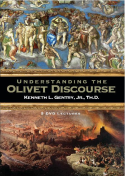
By Ken Gentry
This 5 DVD lecture set was filmed at a Bible Conference in Florida. It explains the entire Olivet Discourse in Matt. 24–25 from the (orthodox) preterist perspective. This lecture series begins by carefully analyzing Matt. 24:3, which establishes the two-part structure of the Discourse. It shows that the first section of the Discourse (Matt. 24:4–35) deals with the coming destruction of the temple and Jerusalem in AD 70. This important prophetic event is also theologically linked to the Final Judgment at the end of history, toward which AD 70 is a distant pointer.
For more educational materials: www. KennethGentry.com
Nor are the amillennialists correct when most of them argue that Christ mixes up AD 70 and Second Advent prophecies and it is up to us to sort them out. Such a hodge-podge approach to this well structured Discourse is simply not possible.
How then can I change my previous view and now hold that Matt 24:27 actually does speak of the Second Advent? After all this statement occurs before the transition passage! Actually it is quite easy, and most reasonable. And it was staring me in the face even while I held to my previous position. The context actually demands this! Let me explain.
In Matt 24:24–26 Jesus warns his disciples of “false Christs and false prophets” who “will arise and will show great signs and wonders, so as to mislead, if possible, even the elect.” He declares: “”Behold, I have told you in advance. So if they say to you, ‘Behold, He is in the wilderness,’ do not go out, or, ‘Behold, He is in the inner rooms,’ do not believe them.” He is about to die and return to the Father in heaven; he will no longer physically be on earth.
This warning was quite necessary in those days. For as we see in Josephus, many men attempted to present themselves as prophets and messiahs. Josephus records for us the following incidents that occur before the outbreak of the Jewish War with Rome.
“There was also another body of wicked men gotten together, not so impure in their actions, but more wicked in their intentions, who laid waste the happy state of the city [Jerusalem] no less than did these murderers. These were such men as deceived and deluded the people under pretense of divine inspiration, but were for procuring innovations and changes of the government; and these prevailed with the multitude to act like madmen, and went before them into the wilderness, as pretending that God would there shew them the signal of liberty.” (J.W. 2:13:4 §258–59)]
“There was an Egyptian false prophet that did the Jews more mischief than the former; for he was a cheat, and pretended to be a prophet also, and got together thirty thousand men that were deluded by him; these he led round about from the wilderness to the mount which was called the Mount of Olives, and was ready to break into Jerusalem by force from that place.” (J.W. 2:13:5 §261–62)

As It Is Written: The Genesis Account Literal or Literary?
Book by Ken Gentry
Presents the exegetical evidence for Six-day Creation and against the Framework Hypothesis. Strong presentation and rebuttal to the Framework Hypothesis, while demonstrating and defending the Six-day Creation interpretation.
See more study materials at: www.KennethGentry.com
A false prophet was the occasion of these people’s destruction, who had made a public proclamation in the city that very day, that God commanded them to get up upon the temple, and there should received miraculous signs of their deliverance. Now, there was then a great number of false prophets suborned by the tyrants to impose upon the people, who denounced this to them, that they should wait for deliverance from God. (J.W. 6:5:2 §285–86)
The Lord is here cautioning his disciples: “If therefore they say to you, ‘Behold, He is in the wilderness,’ do not go forth, or, ‘Behold, He is in the inner rooms,’ do not believe them” (Matt 24:26). We must recall Josephus’ report in Jewish Wars (2:13:5 §261–62) cited above, that recorded an episode in which an Egyptian false prophet arose in the wilderness claiming a great deliverance.
Jesus dismisses such by stating that when he actually physically return to the earth, it will be an unmistakable event: “For just as the lightning comes from the east, and flashes even to the west, so shall the coming of the Son of Man be” (Matt 24:27). The “for” (gar) here shows that he is giving the reason why his disciples should not think he is off in some wilderness or in an inner room somewhere. When he does return it will be as visible and dramatic as lightning flashing.
GOODBIRTH AND THE TWO AGES
I am currently researching a technical study on the concept of the Two Ages in Scripture. This study is not only important for understanding the proper biblical concept of the structure of redemptive history. But it is also absolutely essential for fully grasping the significance of the Disciples’ questions in Matthew 24:3, which spark the Olivet Discourse. This book will be the forerunner to a fuller commentary on the Olivet Discourse in Matthew’s comprehensive presentation. This issue must be dealt with before one can seriously delve into the Discourse itself.
If you would like to support me in my research, I invite you to consider giving a tax-deductible contribution to my research and writing ministry: GoodBirth Ministries. Your help is much appreciated! https://www.paypal.com/donate/?cmd=_s-xclick&hosted_button_id=4XXFLGKEQU48C&ssrt=1740411591428
Kenneth L. Gentry Jr.'s Blog
- Kenneth L. Gentry Jr.'s profile
- 85 followers




